An Investigation of the Nigerian Banking Industry
VerifiedAdded on 2019/12/28
|19
|5019
|254
Report
AI Summary
The assignment content provides a comprehensive overview of the Nigerian banking industry, highlighting key factors that impact its performance. It draws from various research studies and articles published in reputable journals. The topics covered include environmental management, human resource management, lean manufacturing, talent management, regional development, employee training and development, corporate strategy, and sustainability. The summaries provide an insight into how these factors can be leveraged to improve the competitiveness of the Nigerian banking industry. It is essential for stakeholders to understand the importance of each factor in driving success in this industry.
Contribute Materials
Your contribution can guide someone’s learning journey. Share your
documents today.
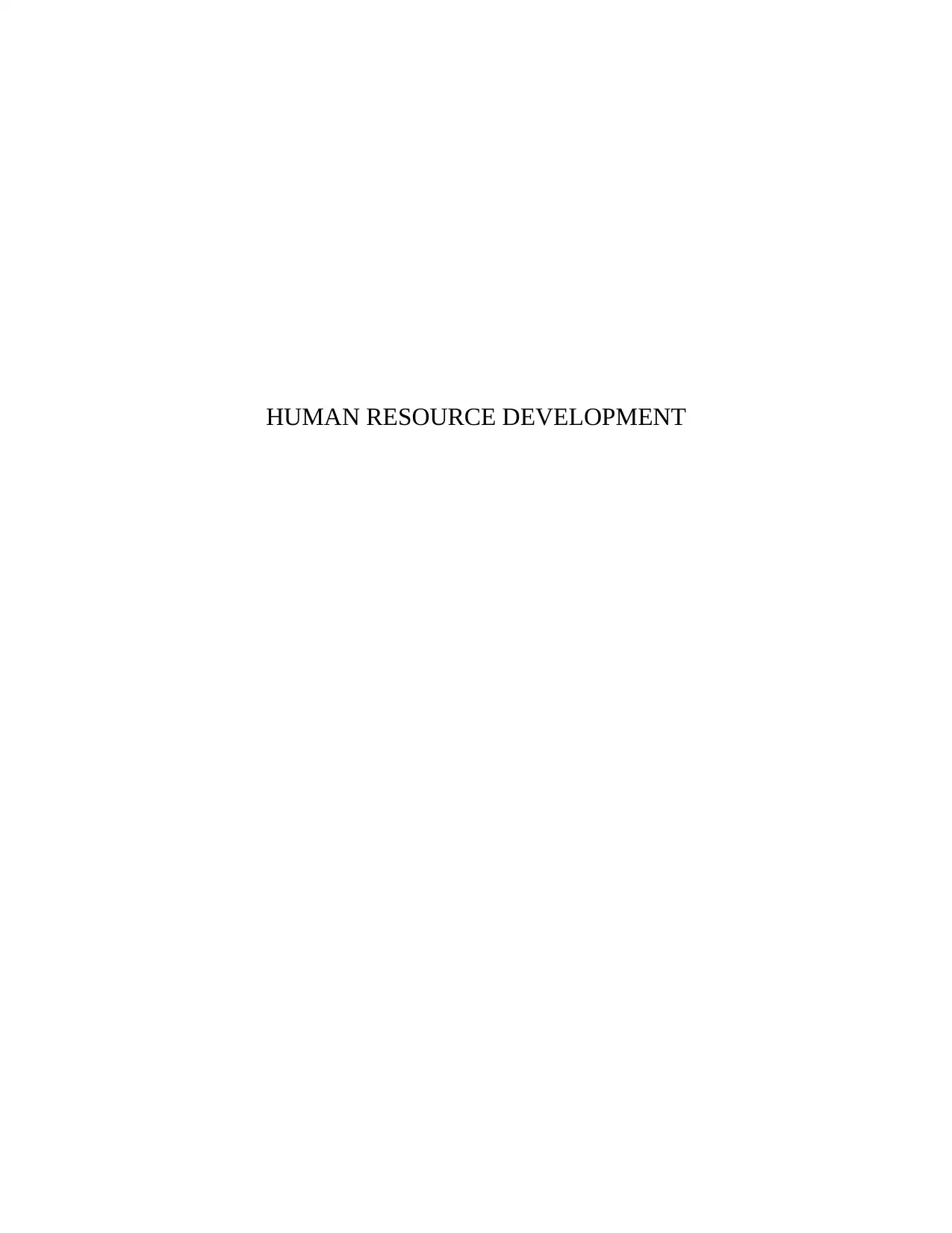
HUMAN RESOURCE DEVELOPMENT
Secure Best Marks with AI Grader
Need help grading? Try our AI Grader for instant feedback on your assignments.
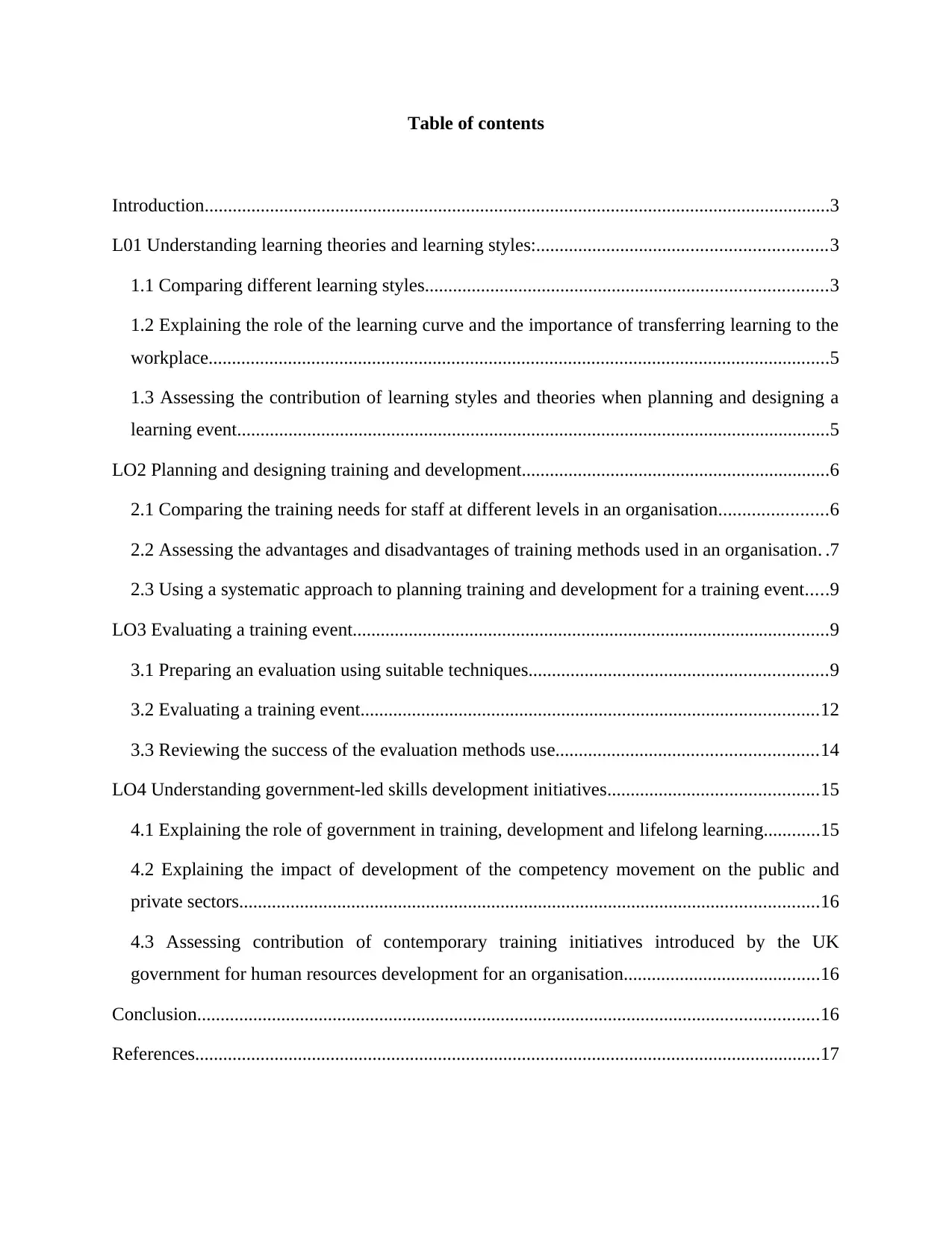
Table of contents
Introduction......................................................................................................................................3
L01 Understanding learning theories and learning styles:..............................................................3
1.1 Comparing different learning styles......................................................................................3
1.2 Explaining the role of the learning curve and the importance of transferring learning to the
workplace.....................................................................................................................................5
1.3 Assessing the contribution of learning styles and theories when planning and designing a
learning event...............................................................................................................................5
LO2 Planning and designing training and development..................................................................6
2.1 Comparing the training needs for staff at different levels in an organisation.......................6
2.2 Assessing the advantages and disadvantages of training methods used in an organisation. .7
2.3 Using a systematic approach to planning training and development for a training event.....9
LO3 Evaluating a training event......................................................................................................9
3.1 Preparing an evaluation using suitable techniques................................................................9
3.2 Evaluating a training event..................................................................................................12
3.3 Reviewing the success of the evaluation methods use........................................................14
LO4 Understanding government-led skills development initiatives.............................................15
4.1 Explaining the role of government in training, development and lifelong learning............15
4.2 Explaining the impact of development of the competency movement on the public and
private sectors............................................................................................................................16
4.3 Assessing contribution of contemporary training initiatives introduced by the UK
government for human resources development for an organisation..........................................16
Conclusion.....................................................................................................................................16
References......................................................................................................................................17
Introduction......................................................................................................................................3
L01 Understanding learning theories and learning styles:..............................................................3
1.1 Comparing different learning styles......................................................................................3
1.2 Explaining the role of the learning curve and the importance of transferring learning to the
workplace.....................................................................................................................................5
1.3 Assessing the contribution of learning styles and theories when planning and designing a
learning event...............................................................................................................................5
LO2 Planning and designing training and development..................................................................6
2.1 Comparing the training needs for staff at different levels in an organisation.......................6
2.2 Assessing the advantages and disadvantages of training methods used in an organisation. .7
2.3 Using a systematic approach to planning training and development for a training event.....9
LO3 Evaluating a training event......................................................................................................9
3.1 Preparing an evaluation using suitable techniques................................................................9
3.2 Evaluating a training event..................................................................................................12
3.3 Reviewing the success of the evaluation methods use........................................................14
LO4 Understanding government-led skills development initiatives.............................................15
4.1 Explaining the role of government in training, development and lifelong learning............15
4.2 Explaining the impact of development of the competency movement on the public and
private sectors............................................................................................................................16
4.3 Assessing contribution of contemporary training initiatives introduced by the UK
government for human resources development for an organisation..........................................16
Conclusion.....................................................................................................................................16
References......................................................................................................................................17
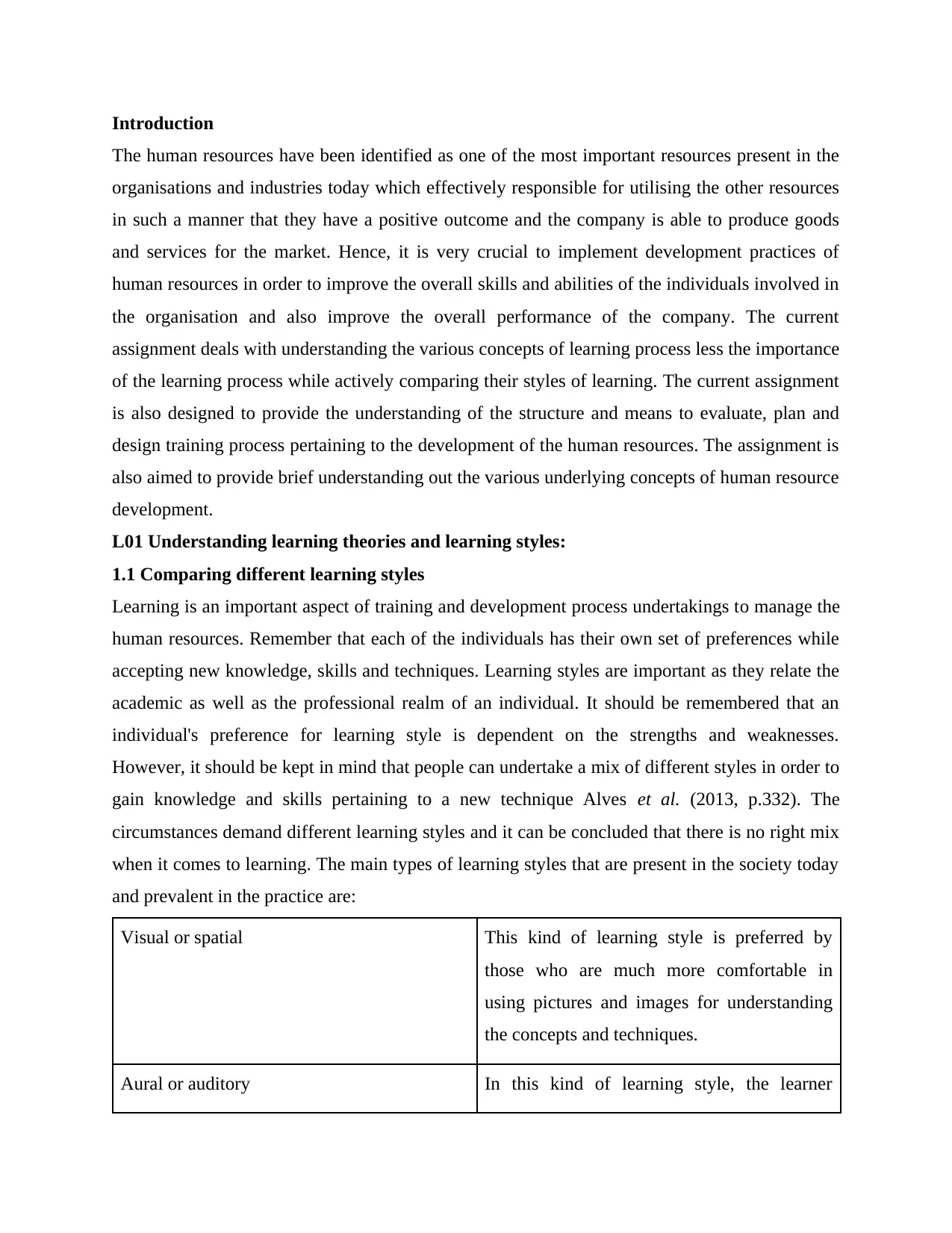
Introduction
The human resources have been identified as one of the most important resources present in the
organisations and industries today which effectively responsible for utilising the other resources
in such a manner that they have a positive outcome and the company is able to produce goods
and services for the market. Hence, it is very crucial to implement development practices of
human resources in order to improve the overall skills and abilities of the individuals involved in
the organisation and also improve the overall performance of the company. The current
assignment deals with understanding the various concepts of learning process less the importance
of the learning process while actively comparing their styles of learning. The current assignment
is also designed to provide the understanding of the structure and means to evaluate, plan and
design training process pertaining to the development of the human resources. The assignment is
also aimed to provide brief understanding out the various underlying concepts of human resource
development.
L01 Understanding learning theories and learning styles:
1.1 Comparing different learning styles
Learning is an important aspect of training and development process undertakings to manage the
human resources. Remember that each of the individuals has their own set of preferences while
accepting new knowledge, skills and techniques. Learning styles are important as they relate the
academic as well as the professional realm of an individual. It should be remembered that an
individual's preference for learning style is dependent on the strengths and weaknesses.
However, it should be kept in mind that people can undertake a mix of different styles in order to
gain knowledge and skills pertaining to a new technique Alves et al. (2013, p.332). The
circumstances demand different learning styles and it can be concluded that there is no right mix
when it comes to learning. The main types of learning styles that are present in the society today
and prevalent in the practice are:
Visual or spatial This kind of learning style is preferred by
those who are much more comfortable in
using pictures and images for understanding
the concepts and techniques.
Aural or auditory In this kind of learning style, the learner
The human resources have been identified as one of the most important resources present in the
organisations and industries today which effectively responsible for utilising the other resources
in such a manner that they have a positive outcome and the company is able to produce goods
and services for the market. Hence, it is very crucial to implement development practices of
human resources in order to improve the overall skills and abilities of the individuals involved in
the organisation and also improve the overall performance of the company. The current
assignment deals with understanding the various concepts of learning process less the importance
of the learning process while actively comparing their styles of learning. The current assignment
is also designed to provide the understanding of the structure and means to evaluate, plan and
design training process pertaining to the development of the human resources. The assignment is
also aimed to provide brief understanding out the various underlying concepts of human resource
development.
L01 Understanding learning theories and learning styles:
1.1 Comparing different learning styles
Learning is an important aspect of training and development process undertakings to manage the
human resources. Remember that each of the individuals has their own set of preferences while
accepting new knowledge, skills and techniques. Learning styles are important as they relate the
academic as well as the professional realm of an individual. It should be remembered that an
individual's preference for learning style is dependent on the strengths and weaknesses.
However, it should be kept in mind that people can undertake a mix of different styles in order to
gain knowledge and skills pertaining to a new technique Alves et al. (2013, p.332). The
circumstances demand different learning styles and it can be concluded that there is no right mix
when it comes to learning. The main types of learning styles that are present in the society today
and prevalent in the practice are:
Visual or spatial This kind of learning style is preferred by
those who are much more comfortable in
using pictures and images for understanding
the concepts and techniques.
Aural or auditory In this kind of learning style, the learner
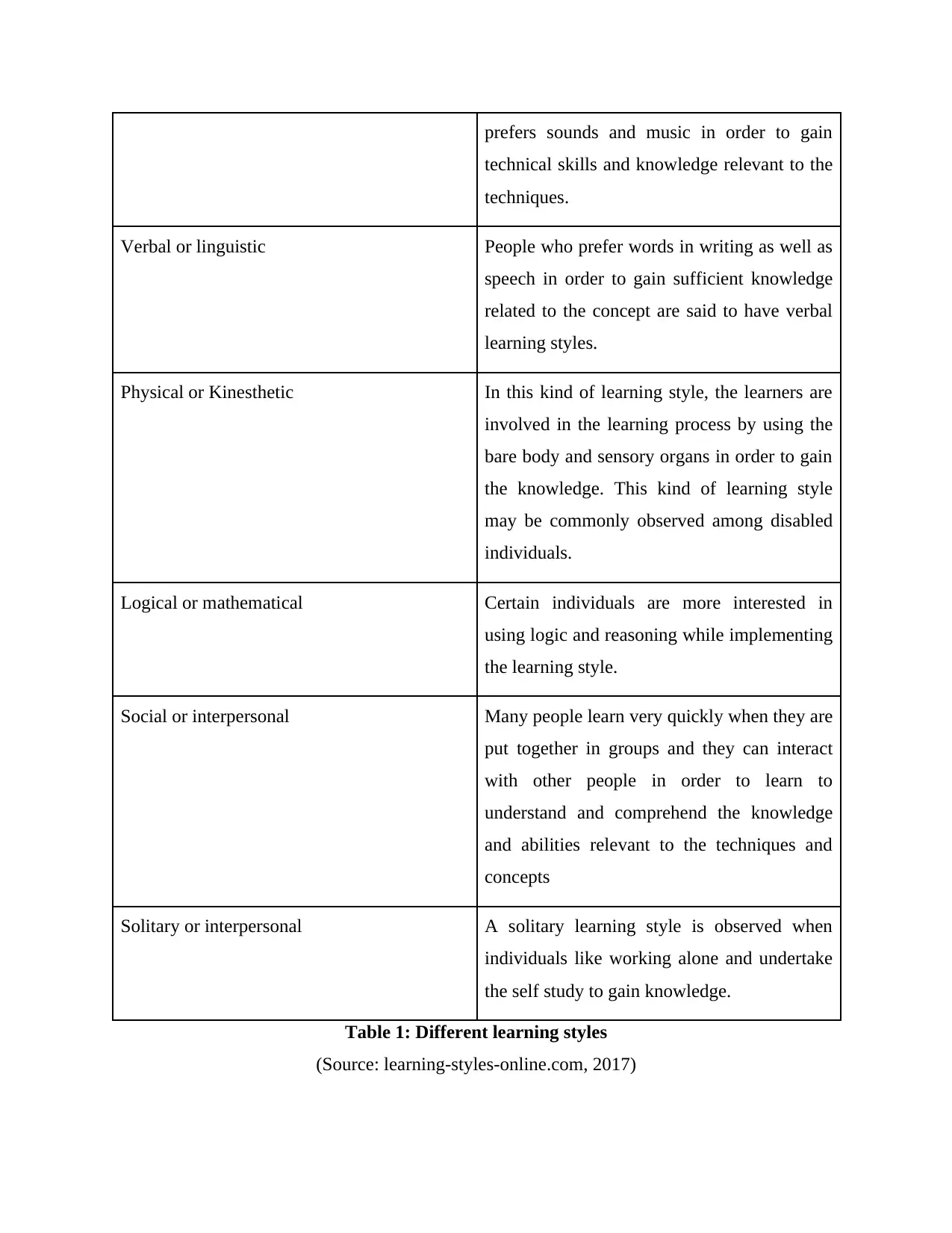
prefers sounds and music in order to gain
technical skills and knowledge relevant to the
techniques.
Verbal or linguistic People who prefer words in writing as well as
speech in order to gain sufficient knowledge
related to the concept are said to have verbal
learning styles.
Physical or Kinesthetic In this kind of learning style, the learners are
involved in the learning process by using the
bare body and sensory organs in order to gain
the knowledge. This kind of learning style
may be commonly observed among disabled
individuals.
Logical or mathematical Certain individuals are more interested in
using logic and reasoning while implementing
the learning style.
Social or interpersonal Many people learn very quickly when they are
put together in groups and they can interact
with other people in order to learn to
understand and comprehend the knowledge
and abilities relevant to the techniques and
concepts
Solitary or interpersonal A solitary learning style is observed when
individuals like working alone and undertake
the self study to gain knowledge.
Table 1: Different learning styles
(Source: learning-styles-online.com, 2017)
technical skills and knowledge relevant to the
techniques.
Verbal or linguistic People who prefer words in writing as well as
speech in order to gain sufficient knowledge
related to the concept are said to have verbal
learning styles.
Physical or Kinesthetic In this kind of learning style, the learners are
involved in the learning process by using the
bare body and sensory organs in order to gain
the knowledge. This kind of learning style
may be commonly observed among disabled
individuals.
Logical or mathematical Certain individuals are more interested in
using logic and reasoning while implementing
the learning style.
Social or interpersonal Many people learn very quickly when they are
put together in groups and they can interact
with other people in order to learn to
understand and comprehend the knowledge
and abilities relevant to the techniques and
concepts
Solitary or interpersonal A solitary learning style is observed when
individuals like working alone and undertake
the self study to gain knowledge.
Table 1: Different learning styles
(Source: learning-styles-online.com, 2017)
Secure Best Marks with AI Grader
Need help grading? Try our AI Grader for instant feedback on your assignments.
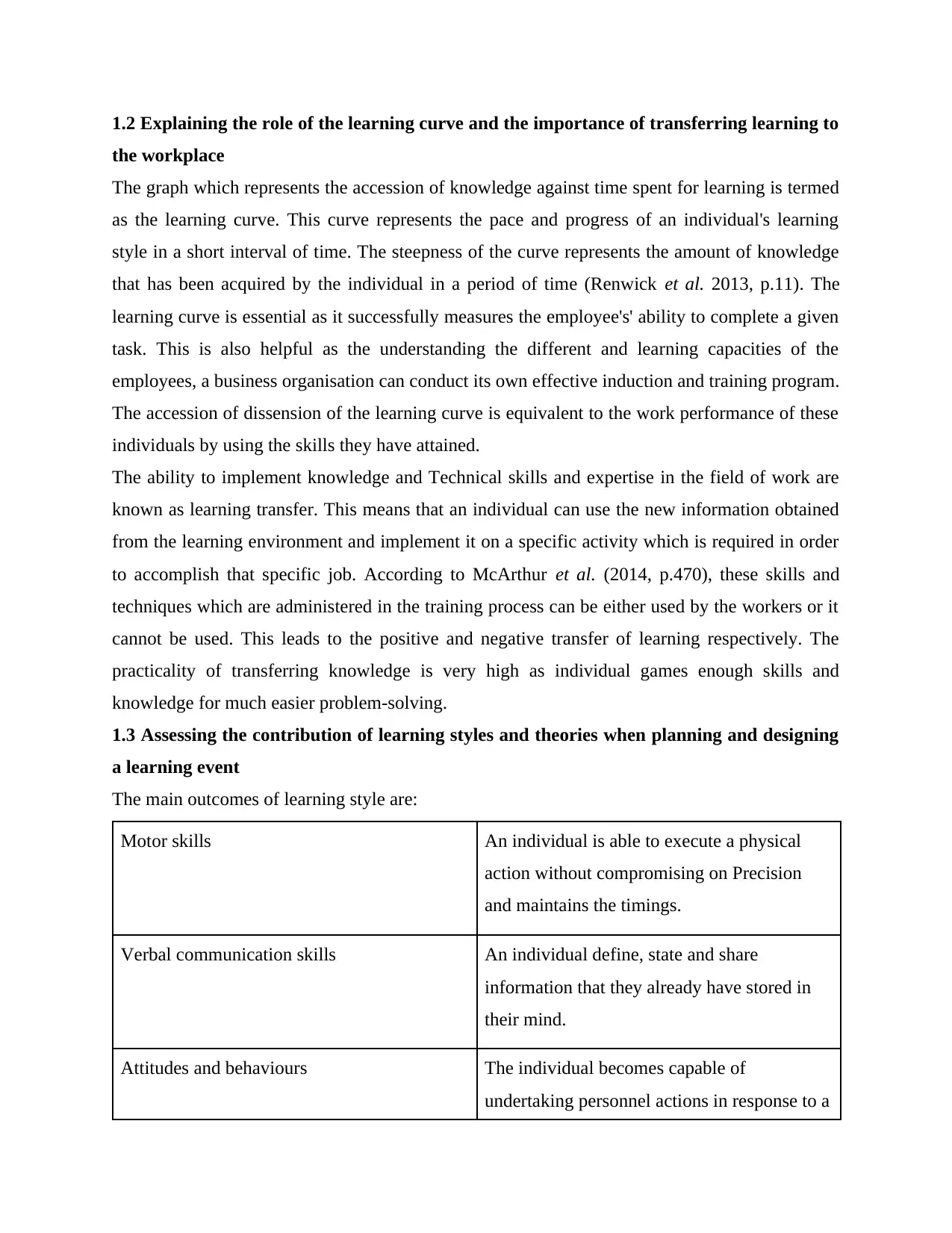
1.2 Explaining the role of the learning curve and the importance of transferring learning to
the workplace
The graph which represents the accession of knowledge against time spent for learning is termed
as the learning curve. This curve represents the pace and progress of an individual's learning
style in a short interval of time. The steepness of the curve represents the amount of knowledge
that has been acquired by the individual in a period of time (Renwick et al. 2013, p.11). The
learning curve is essential as it successfully measures the employee's' ability to complete a given
task. This is also helpful as the understanding the different and learning capacities of the
employees, a business organisation can conduct its own effective induction and training program.
The accession of dissension of the learning curve is equivalent to the work performance of these
individuals by using the skills they have attained.
The ability to implement knowledge and Technical skills and expertise in the field of work are
known as learning transfer. This means that an individual can use the new information obtained
from the learning environment and implement it on a specific activity which is required in order
to accomplish that specific job. According to McArthur et al. (2014, p.470), these skills and
techniques which are administered in the training process can be either used by the workers or it
cannot be used. This leads to the positive and negative transfer of learning respectively. The
practicality of transferring knowledge is very high as individual games enough skills and
knowledge for much easier problem-solving.
1.3 Assessing the contribution of learning styles and theories when planning and designing
a learning event
The main outcomes of learning style are:
Motor skills An individual is able to execute a physical
action without compromising on Precision
and maintains the timings.
Verbal communication skills An individual define, state and share
information that they already have stored in
their mind.
Attitudes and behaviours The individual becomes capable of
undertaking personnel actions in response to a
the workplace
The graph which represents the accession of knowledge against time spent for learning is termed
as the learning curve. This curve represents the pace and progress of an individual's learning
style in a short interval of time. The steepness of the curve represents the amount of knowledge
that has been acquired by the individual in a period of time (Renwick et al. 2013, p.11). The
learning curve is essential as it successfully measures the employee's' ability to complete a given
task. This is also helpful as the understanding the different and learning capacities of the
employees, a business organisation can conduct its own effective induction and training program.
The accession of dissension of the learning curve is equivalent to the work performance of these
individuals by using the skills they have attained.
The ability to implement knowledge and Technical skills and expertise in the field of work are
known as learning transfer. This means that an individual can use the new information obtained
from the learning environment and implement it on a specific activity which is required in order
to accomplish that specific job. According to McArthur et al. (2014, p.470), these skills and
techniques which are administered in the training process can be either used by the workers or it
cannot be used. This leads to the positive and negative transfer of learning respectively. The
practicality of transferring knowledge is very high as individual games enough skills and
knowledge for much easier problem-solving.
1.3 Assessing the contribution of learning styles and theories when planning and designing
a learning event
The main outcomes of learning style are:
Motor skills An individual is able to execute a physical
action without compromising on Precision
and maintains the timings.
Verbal communication skills An individual define, state and share
information that they already have stored in
their mind.
Attitudes and behaviours The individual becomes capable of
undertaking personnel actions in response to a
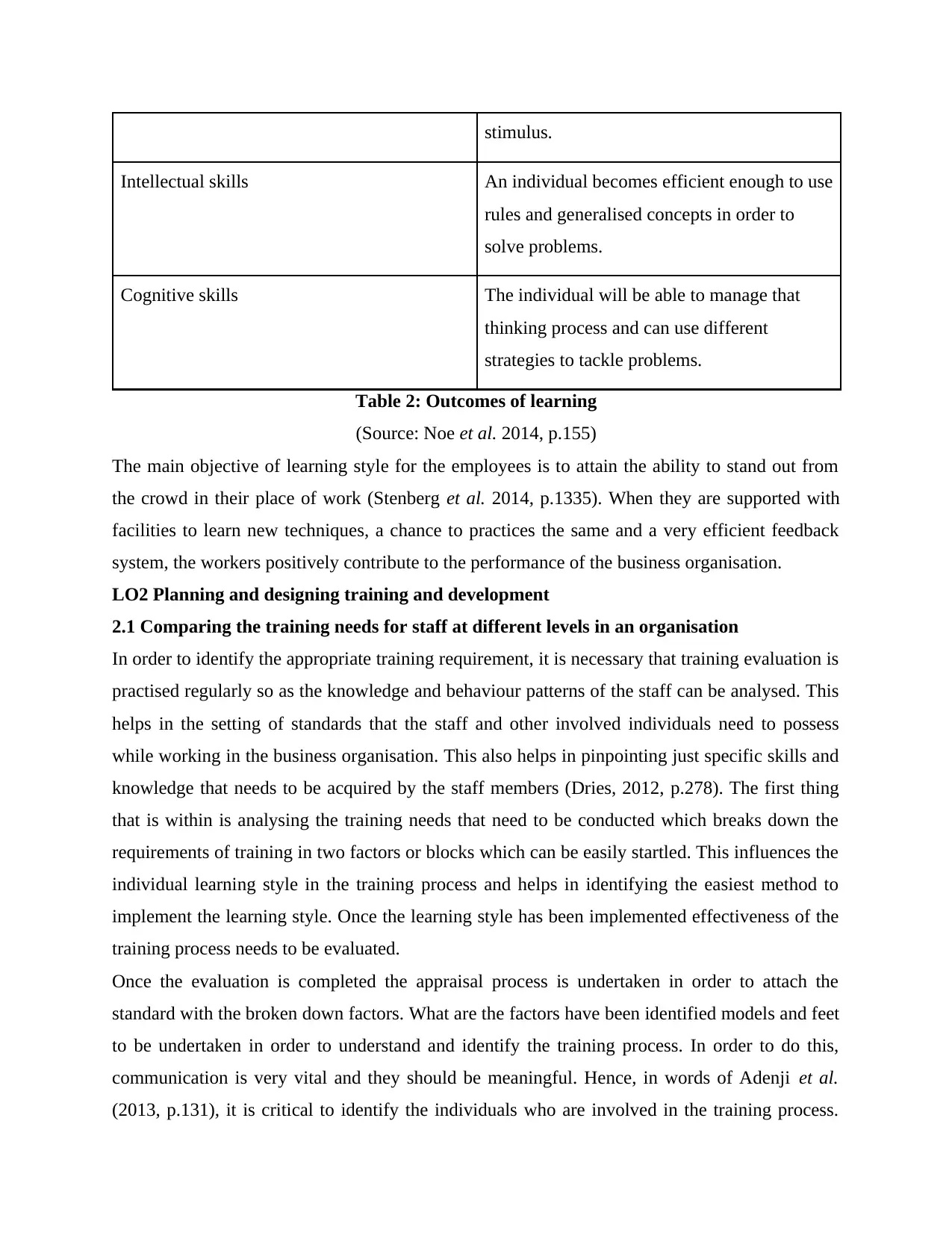
stimulus.
Intellectual skills An individual becomes efficient enough to use
rules and generalised concepts in order to
solve problems.
Cognitive skills The individual will be able to manage that
thinking process and can use different
strategies to tackle problems.
Table 2: Outcomes of learning
(Source: Noe et al. 2014, p.155)
The main objective of learning style for the employees is to attain the ability to stand out from
the crowd in their place of work (Stenberg et al. 2014, p.1335). When they are supported with
facilities to learn new techniques, a chance to practices the same and a very efficient feedback
system, the workers positively contribute to the performance of the business organisation.
LO2 Planning and designing training and development
2.1 Comparing the training needs for staff at different levels in an organisation
In order to identify the appropriate training requirement, it is necessary that training evaluation is
practised regularly so as the knowledge and behaviour patterns of the staff can be analysed. This
helps in the setting of standards that the staff and other involved individuals need to possess
while working in the business organisation. This also helps in pinpointing just specific skills and
knowledge that needs to be acquired by the staff members (Dries, 2012, p.278). The first thing
that is within is analysing the training needs that need to be conducted which breaks down the
requirements of training in two factors or blocks which can be easily startled. This influences the
individual learning style in the training process and helps in identifying the easiest method to
implement the learning style. Once the learning style has been implemented effectiveness of the
training process needs to be evaluated.
Once the evaluation is completed the appraisal process is undertaken in order to attach the
standard with the broken down factors. What are the factors have been identified models and feet
to be undertaken in order to understand and identify the training process. In order to do this,
communication is very vital and they should be meaningful. Hence, in words of Adenji et al.
(2013, p.131), it is critical to identify the individuals who are involved in the training process.
Intellectual skills An individual becomes efficient enough to use
rules and generalised concepts in order to
solve problems.
Cognitive skills The individual will be able to manage that
thinking process and can use different
strategies to tackle problems.
Table 2: Outcomes of learning
(Source: Noe et al. 2014, p.155)
The main objective of learning style for the employees is to attain the ability to stand out from
the crowd in their place of work (Stenberg et al. 2014, p.1335). When they are supported with
facilities to learn new techniques, a chance to practices the same and a very efficient feedback
system, the workers positively contribute to the performance of the business organisation.
LO2 Planning and designing training and development
2.1 Comparing the training needs for staff at different levels in an organisation
In order to identify the appropriate training requirement, it is necessary that training evaluation is
practised regularly so as the knowledge and behaviour patterns of the staff can be analysed. This
helps in the setting of standards that the staff and other involved individuals need to possess
while working in the business organisation. This also helps in pinpointing just specific skills and
knowledge that needs to be acquired by the staff members (Dries, 2012, p.278). The first thing
that is within is analysing the training needs that need to be conducted which breaks down the
requirements of training in two factors or blocks which can be easily startled. This influences the
individual learning style in the training process and helps in identifying the easiest method to
implement the learning style. Once the learning style has been implemented effectiveness of the
training process needs to be evaluated.
Once the evaluation is completed the appraisal process is undertaken in order to attach the
standard with the broken down factors. What are the factors have been identified models and feet
to be undertaken in order to understand and identify the training process. In order to do this,
communication is very vital and they should be meaningful. Hence, in words of Adenji et al.
(2013, p.131), it is critical to identify the individuals who are involved in the training process.
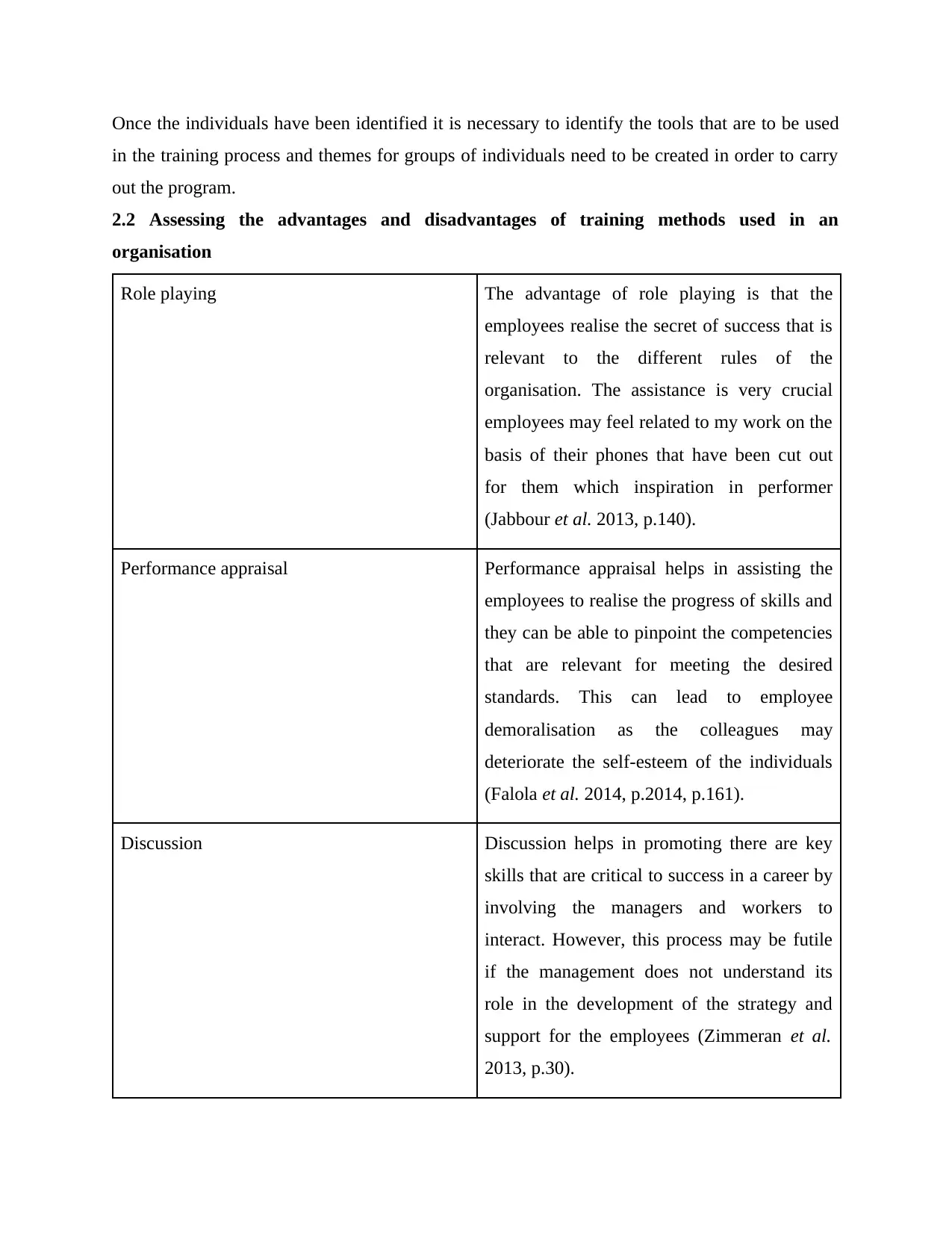
Once the individuals have been identified it is necessary to identify the tools that are to be used
in the training process and themes for groups of individuals need to be created in order to carry
out the program.
2.2 Assessing the advantages and disadvantages of training methods used in an
organisation
Role playing The advantage of role playing is that the
employees realise the secret of success that is
relevant to the different rules of the
organisation. The assistance is very crucial
employees may feel related to my work on the
basis of their phones that have been cut out
for them which inspiration in performer
(Jabbour et al. 2013, p.140).
Performance appraisal Performance appraisal helps in assisting the
employees to realise the progress of skills and
they can be able to pinpoint the competencies
that are relevant for meeting the desired
standards. This can lead to employee
demoralisation as the colleagues may
deteriorate the self-esteem of the individuals
(Falola et al. 2014, p.2014, p.161).
Discussion Discussion helps in promoting there are key
skills that are critical to success in a career by
involving the managers and workers to
interact. However, this process may be futile
if the management does not understand its
role in the development of the strategy and
support for the employees (Zimmeran et al.
2013, p.30).
in the training process and themes for groups of individuals need to be created in order to carry
out the program.
2.2 Assessing the advantages and disadvantages of training methods used in an
organisation
Role playing The advantage of role playing is that the
employees realise the secret of success that is
relevant to the different rules of the
organisation. The assistance is very crucial
employees may feel related to my work on the
basis of their phones that have been cut out
for them which inspiration in performer
(Jabbour et al. 2013, p.140).
Performance appraisal Performance appraisal helps in assisting the
employees to realise the progress of skills and
they can be able to pinpoint the competencies
that are relevant for meeting the desired
standards. This can lead to employee
demoralisation as the colleagues may
deteriorate the self-esteem of the individuals
(Falola et al. 2014, p.2014, p.161).
Discussion Discussion helps in promoting there are key
skills that are critical to success in a career by
involving the managers and workers to
interact. However, this process may be futile
if the management does not understand its
role in the development of the strategy and
support for the employees (Zimmeran et al.
2013, p.30).
Paraphrase This Document
Need a fresh take? Get an instant paraphrase of this document with our AI Paraphraser
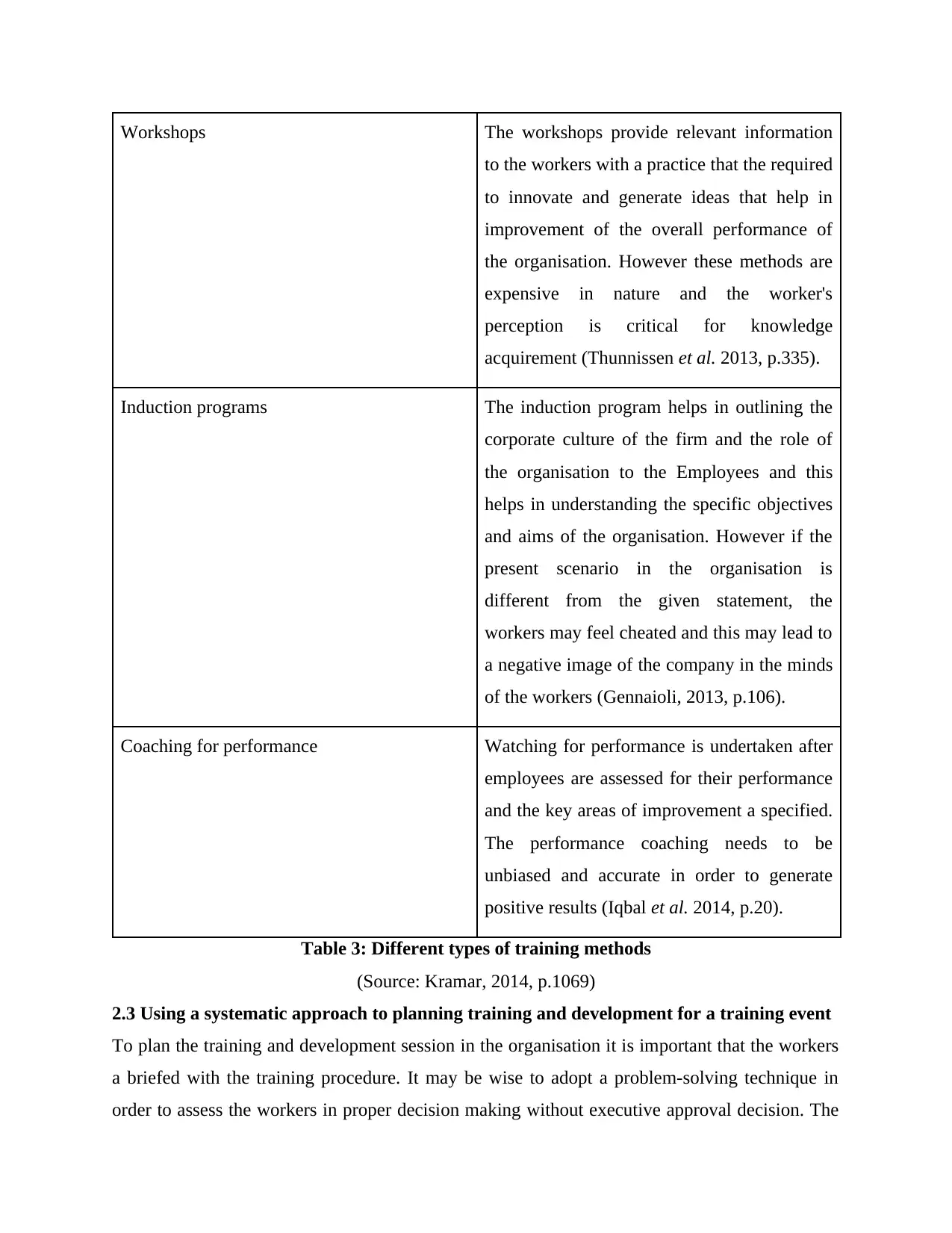
Workshops The workshops provide relevant information
to the workers with a practice that the required
to innovate and generate ideas that help in
improvement of the overall performance of
the organisation. However these methods are
expensive in nature and the worker's
perception is critical for knowledge
acquirement (Thunnissen et al. 2013, p.335).
Induction programs The induction program helps in outlining the
corporate culture of the firm and the role of
the organisation to the Employees and this
helps in understanding the specific objectives
and aims of the organisation. However if the
present scenario in the organisation is
different from the given statement, the
workers may feel cheated and this may lead to
a negative image of the company in the minds
of the workers (Gennaioli, 2013, p.106).
Coaching for performance Watching for performance is undertaken after
employees are assessed for their performance
and the key areas of improvement a specified.
The performance coaching needs to be
unbiased and accurate in order to generate
positive results (Iqbal et al. 2014, p.20).
Table 3: Different types of training methods
(Source: Kramar, 2014, p.1069)
2.3 Using a systematic approach to planning training and development for a training event
To plan the training and development session in the organisation it is important that the workers
a briefed with the training procedure. It may be wise to adopt a problem-solving technique in
order to assess the workers in proper decision making without executive approval decision. The
to the workers with a practice that the required
to innovate and generate ideas that help in
improvement of the overall performance of
the organisation. However these methods are
expensive in nature and the worker's
perception is critical for knowledge
acquirement (Thunnissen et al. 2013, p.335).
Induction programs The induction program helps in outlining the
corporate culture of the firm and the role of
the organisation to the Employees and this
helps in understanding the specific objectives
and aims of the organisation. However if the
present scenario in the organisation is
different from the given statement, the
workers may feel cheated and this may lead to
a negative image of the company in the minds
of the workers (Gennaioli, 2013, p.106).
Coaching for performance Watching for performance is undertaken after
employees are assessed for their performance
and the key areas of improvement a specified.
The performance coaching needs to be
unbiased and accurate in order to generate
positive results (Iqbal et al. 2014, p.20).
Table 3: Different types of training methods
(Source: Kramar, 2014, p.1069)
2.3 Using a systematic approach to planning training and development for a training event
To plan the training and development session in the organisation it is important that the workers
a briefed with the training procedure. It may be wise to adopt a problem-solving technique in
order to assess the workers in proper decision making without executive approval decision. The
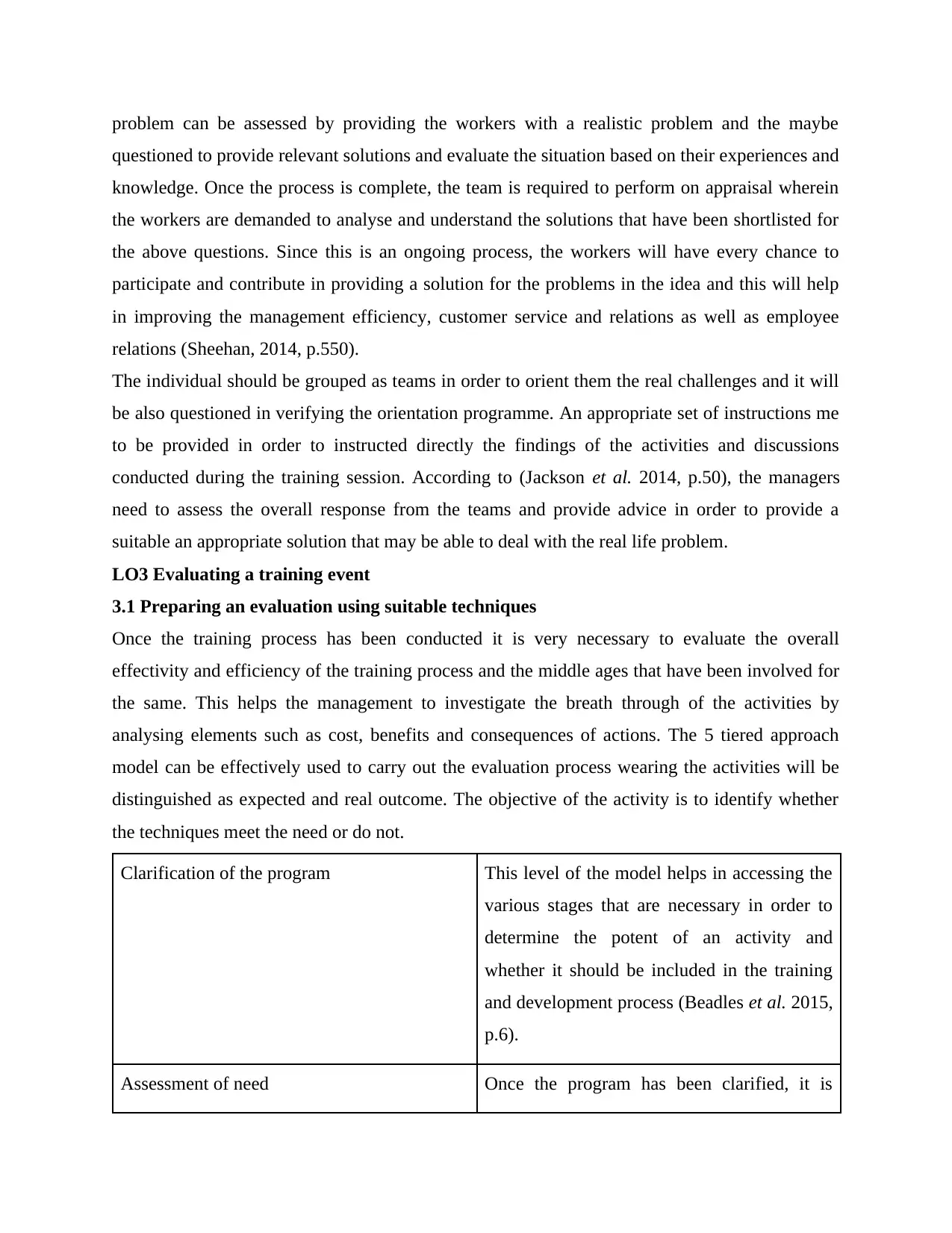
problem can be assessed by providing the workers with a realistic problem and the maybe
questioned to provide relevant solutions and evaluate the situation based on their experiences and
knowledge. Once the process is complete, the team is required to perform on appraisal wherein
the workers are demanded to analyse and understand the solutions that have been shortlisted for
the above questions. Since this is an ongoing process, the workers will have every chance to
participate and contribute in providing a solution for the problems in the idea and this will help
in improving the management efficiency, customer service and relations as well as employee
relations (Sheehan, 2014, p.550).
The individual should be grouped as teams in order to orient them the real challenges and it will
be also questioned in verifying the orientation programme. An appropriate set of instructions me
to be provided in order to instructed directly the findings of the activities and discussions
conducted during the training session. According to (Jackson et al. 2014, p.50), the managers
need to assess the overall response from the teams and provide advice in order to provide a
suitable an appropriate solution that may be able to deal with the real life problem.
LO3 Evaluating a training event
3.1 Preparing an evaluation using suitable techniques
Once the training process has been conducted it is very necessary to evaluate the overall
effectivity and efficiency of the training process and the middle ages that have been involved for
the same. This helps the management to investigate the breath through of the activities by
analysing elements such as cost, benefits and consequences of actions. The 5 tiered approach
model can be effectively used to carry out the evaluation process wearing the activities will be
distinguished as expected and real outcome. The objective of the activity is to identify whether
the techniques meet the need or do not.
Clarification of the program This level of the model helps in accessing the
various stages that are necessary in order to
determine the potent of an activity and
whether it should be included in the training
and development process (Beadles et al. 2015,
p.6).
Assessment of need Once the program has been clarified, it is
questioned to provide relevant solutions and evaluate the situation based on their experiences and
knowledge. Once the process is complete, the team is required to perform on appraisal wherein
the workers are demanded to analyse and understand the solutions that have been shortlisted for
the above questions. Since this is an ongoing process, the workers will have every chance to
participate and contribute in providing a solution for the problems in the idea and this will help
in improving the management efficiency, customer service and relations as well as employee
relations (Sheehan, 2014, p.550).
The individual should be grouped as teams in order to orient them the real challenges and it will
be also questioned in verifying the orientation programme. An appropriate set of instructions me
to be provided in order to instructed directly the findings of the activities and discussions
conducted during the training session. According to (Jackson et al. 2014, p.50), the managers
need to assess the overall response from the teams and provide advice in order to provide a
suitable an appropriate solution that may be able to deal with the real life problem.
LO3 Evaluating a training event
3.1 Preparing an evaluation using suitable techniques
Once the training process has been conducted it is very necessary to evaluate the overall
effectivity and efficiency of the training process and the middle ages that have been involved for
the same. This helps the management to investigate the breath through of the activities by
analysing elements such as cost, benefits and consequences of actions. The 5 tiered approach
model can be effectively used to carry out the evaluation process wearing the activities will be
distinguished as expected and real outcome. The objective of the activity is to identify whether
the techniques meet the need or do not.
Clarification of the program This level of the model helps in accessing the
various stages that are necessary in order to
determine the potent of an activity and
whether it should be included in the training
and development process (Beadles et al. 2015,
p.6).
Assessment of need Once the program has been clarified, it is
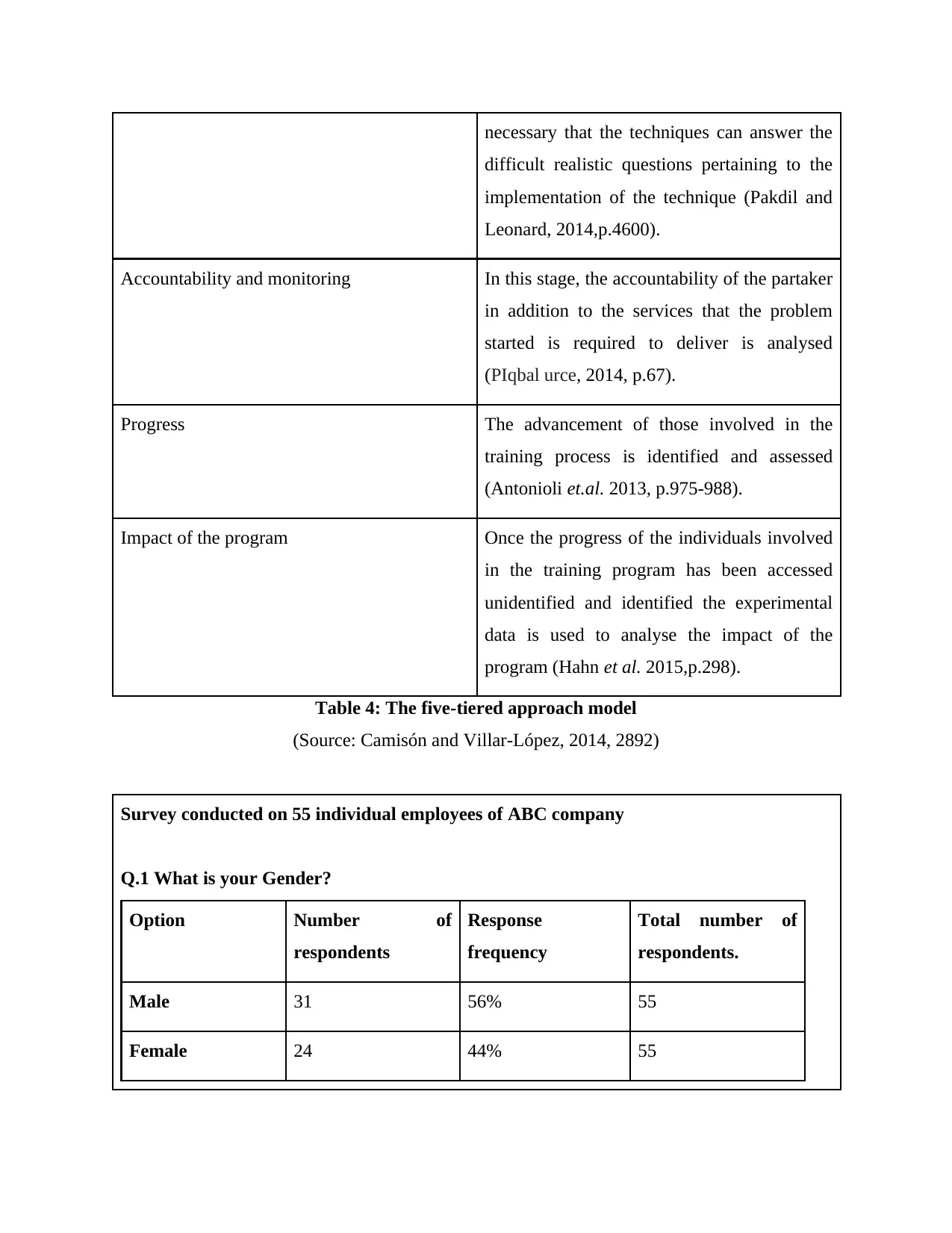
necessary that the techniques can answer the
difficult realistic questions pertaining to the
implementation of the technique (Pakdil and
Leonard, 2014,p.4600).
Accountability and monitoring In this stage, the accountability of the partaker
in addition to the services that the problem
started is required to deliver is analysed
(PIqbal urce, 2014, p.67).
Progress The advancement of those involved in the
training process is identified and assessed
(Antonioli et.al. 2013, p.975-988).
Impact of the program Once the progress of the individuals involved
in the training program has been accessed
unidentified and identified the experimental
data is used to analyse the impact of the
program (Hahn et al. 2015,p.298).
Table 4: The five-tiered approach model
(Source: Camisón and Villar-López, 2014, 2892)
Survey conducted on 55 individual employees of ABC company
Q.1 What is your Gender?
Option Number of
respondents
Response
frequency
Total number of
respondents.
Male 31 56% 55
Female 24 44% 55
difficult realistic questions pertaining to the
implementation of the technique (Pakdil and
Leonard, 2014,p.4600).
Accountability and monitoring In this stage, the accountability of the partaker
in addition to the services that the problem
started is required to deliver is analysed
(PIqbal urce, 2014, p.67).
Progress The advancement of those involved in the
training process is identified and assessed
(Antonioli et.al. 2013, p.975-988).
Impact of the program Once the progress of the individuals involved
in the training program has been accessed
unidentified and identified the experimental
data is used to analyse the impact of the
program (Hahn et al. 2015,p.298).
Table 4: The five-tiered approach model
(Source: Camisón and Villar-López, 2014, 2892)
Survey conducted on 55 individual employees of ABC company
Q.1 What is your Gender?
Option Number of
respondents
Response
frequency
Total number of
respondents.
Male 31 56% 55
Female 24 44% 55
Secure Best Marks with AI Grader
Need help grading? Try our AI Grader for instant feedback on your assignments.
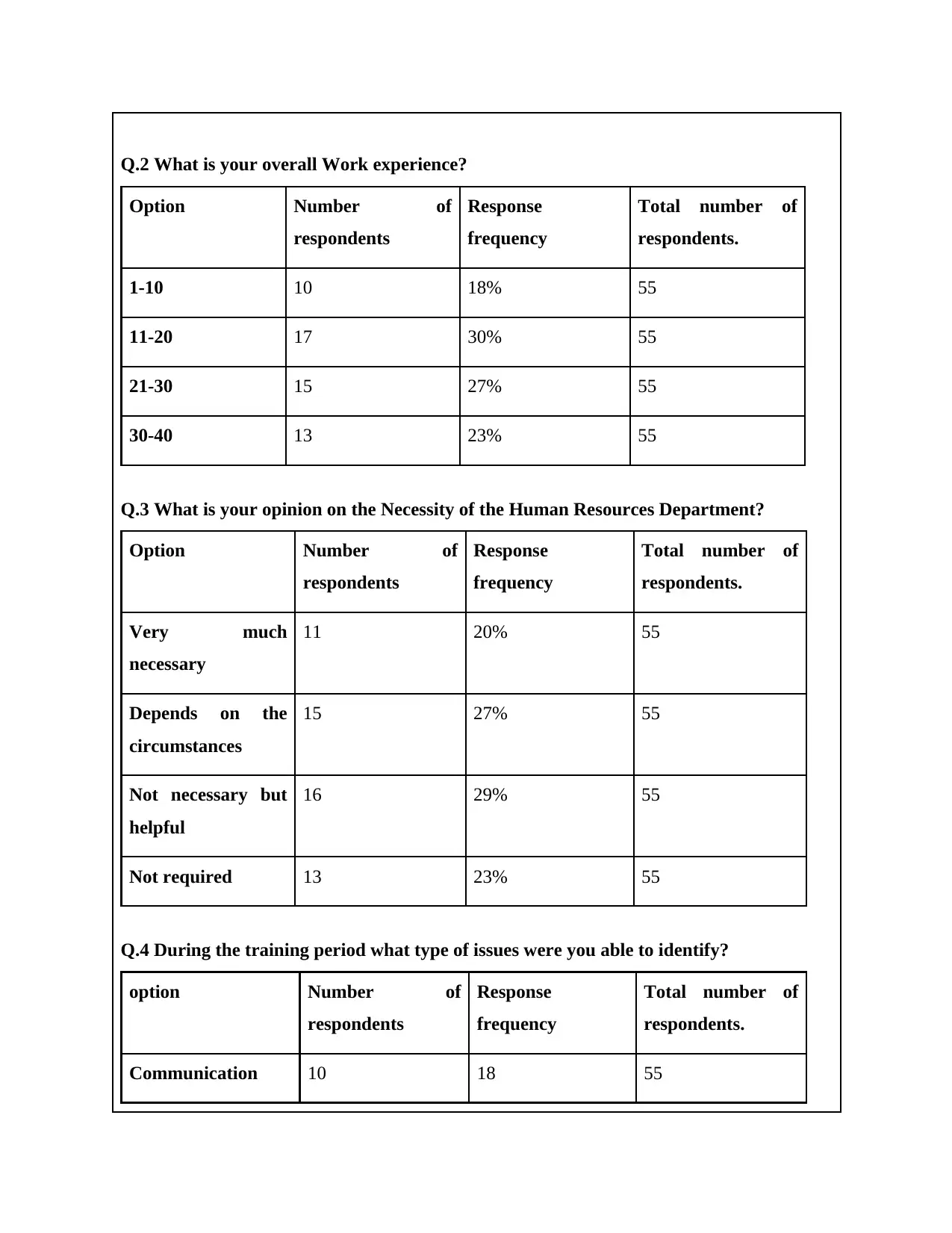
Q.2 What is your overall Work experience?
Option Number of
respondents
Response
frequency
Total number of
respondents.
1-10 10 18% 55
11-20 17 30% 55
21-30 15 27% 55
30-40 13 23% 55
Q.3 What is your opinion on the Necessity of the Human Resources Department?
Option Number of
respondents
Response
frequency
Total number of
respondents.
Very much
necessary
11 20% 55
Depends on the
circumstances
15 27% 55
Not necessary but
helpful
16 29% 55
Not required 13 23% 55
Q.4 During the training period what type of issues were you able to identify?
option Number of
respondents
Response
frequency
Total number of
respondents.
Communication 10 18 55
Option Number of
respondents
Response
frequency
Total number of
respondents.
1-10 10 18% 55
11-20 17 30% 55
21-30 15 27% 55
30-40 13 23% 55
Q.3 What is your opinion on the Necessity of the Human Resources Department?
Option Number of
respondents
Response
frequency
Total number of
respondents.
Very much
necessary
11 20% 55
Depends on the
circumstances
15 27% 55
Not necessary but
helpful
16 29% 55
Not required 13 23% 55
Q.4 During the training period what type of issues were you able to identify?
option Number of
respondents
Response
frequency
Total number of
respondents.
Communication 10 18 55
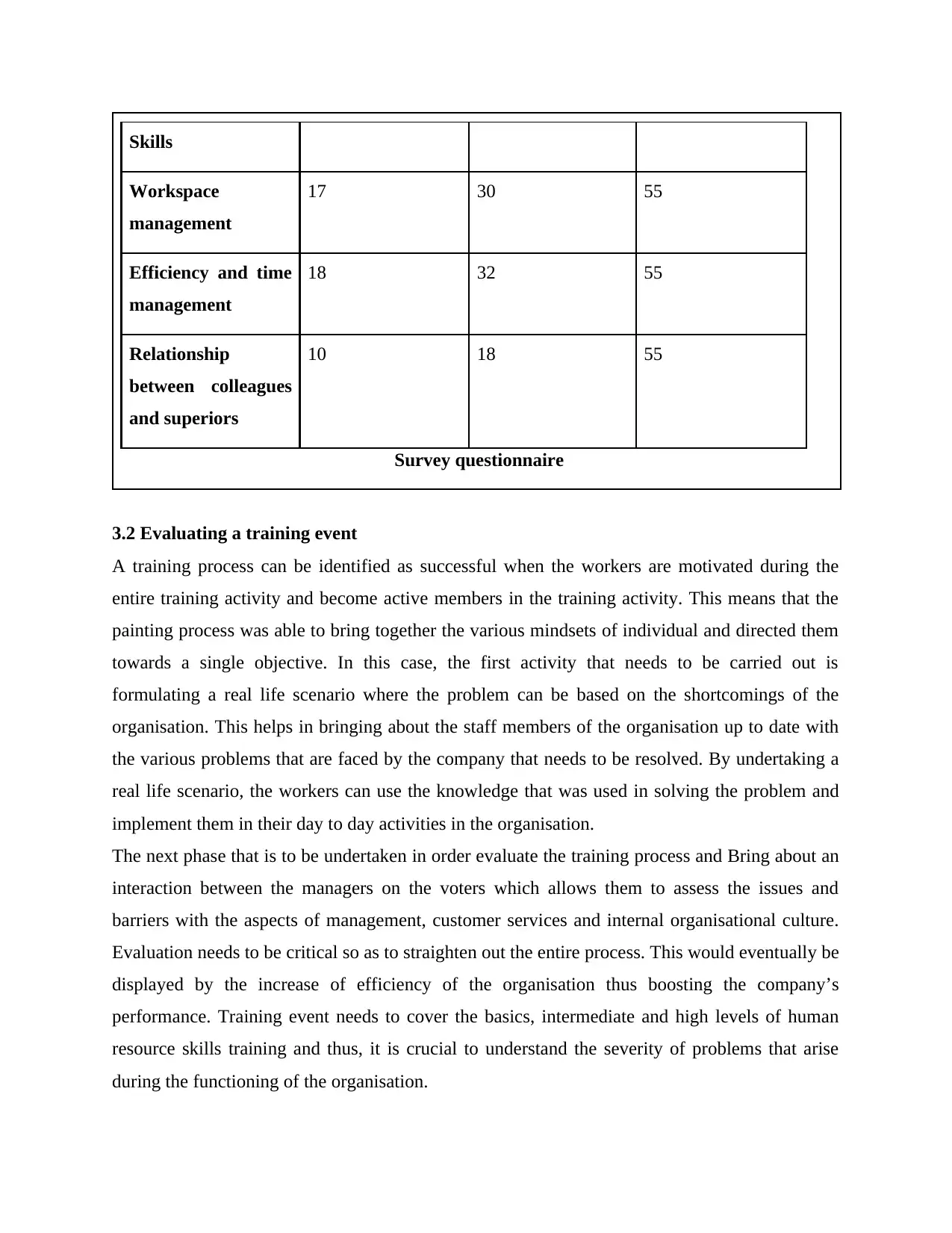
Skills
Workspace
management
17 30 55
Efficiency and time
management
18 32 55
Relationship
between colleagues
and superiors
10 18 55
Survey questionnaire
3.2 Evaluating a training event
A training process can be identified as successful when the workers are motivated during the
entire training activity and become active members in the training activity. This means that the
painting process was able to bring together the various mindsets of individual and directed them
towards a single objective. In this case, the first activity that needs to be carried out is
formulating a real life scenario where the problem can be based on the shortcomings of the
organisation. This helps in bringing about the staff members of the organisation up to date with
the various problems that are faced by the company that needs to be resolved. By undertaking a
real life scenario, the workers can use the knowledge that was used in solving the problem and
implement them in their day to day activities in the organisation.
The next phase that is to be undertaken in order evaluate the training process and Bring about an
interaction between the managers on the voters which allows them to assess the issues and
barriers with the aspects of management, customer services and internal organisational culture.
Evaluation needs to be critical so as to straighten out the entire process. This would eventually be
displayed by the increase of efficiency of the organisation thus boosting the company’s
performance. Training event needs to cover the basics, intermediate and high levels of human
resource skills training and thus, it is crucial to understand the severity of problems that arise
during the functioning of the organisation.
Workspace
management
17 30 55
Efficiency and time
management
18 32 55
Relationship
between colleagues
and superiors
10 18 55
Survey questionnaire
3.2 Evaluating a training event
A training process can be identified as successful when the workers are motivated during the
entire training activity and become active members in the training activity. This means that the
painting process was able to bring together the various mindsets of individual and directed them
towards a single objective. In this case, the first activity that needs to be carried out is
formulating a real life scenario where the problem can be based on the shortcomings of the
organisation. This helps in bringing about the staff members of the organisation up to date with
the various problems that are faced by the company that needs to be resolved. By undertaking a
real life scenario, the workers can use the knowledge that was used in solving the problem and
implement them in their day to day activities in the organisation.
The next phase that is to be undertaken in order evaluate the training process and Bring about an
interaction between the managers on the voters which allows them to assess the issues and
barriers with the aspects of management, customer services and internal organisational culture.
Evaluation needs to be critical so as to straighten out the entire process. This would eventually be
displayed by the increase of efficiency of the organisation thus boosting the company’s
performance. Training event needs to cover the basics, intermediate and high levels of human
resource skills training and thus, it is crucial to understand the severity of problems that arise
during the functioning of the organisation.
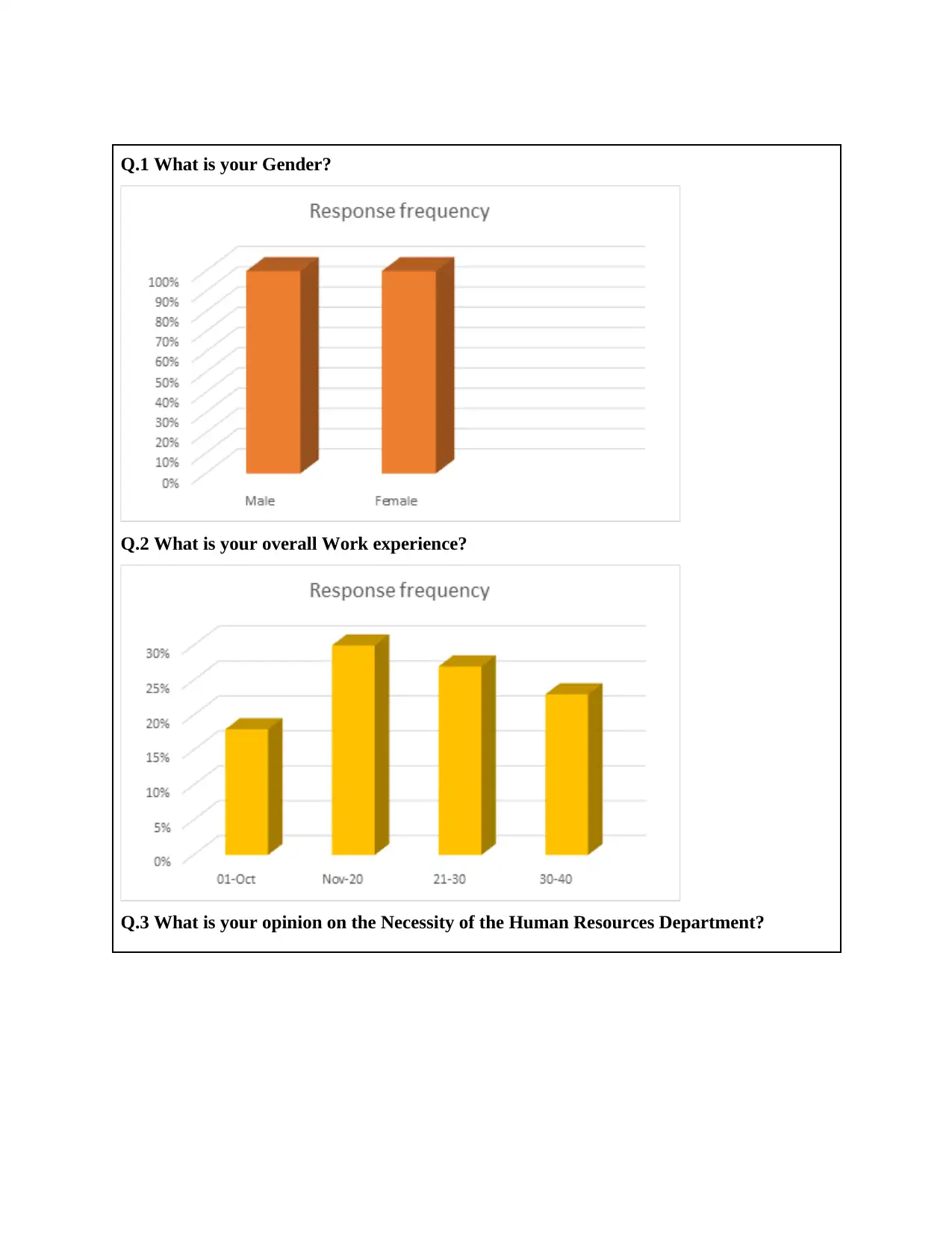
Q.1 What is your Gender?
Q.2 What is your overall Work experience?
Q.3 What is your opinion on the Necessity of the Human Resources Department?
Q.2 What is your overall Work experience?
Q.3 What is your opinion on the Necessity of the Human Resources Department?
Paraphrase This Document
Need a fresh take? Get an instant paraphrase of this document with our AI Paraphraser
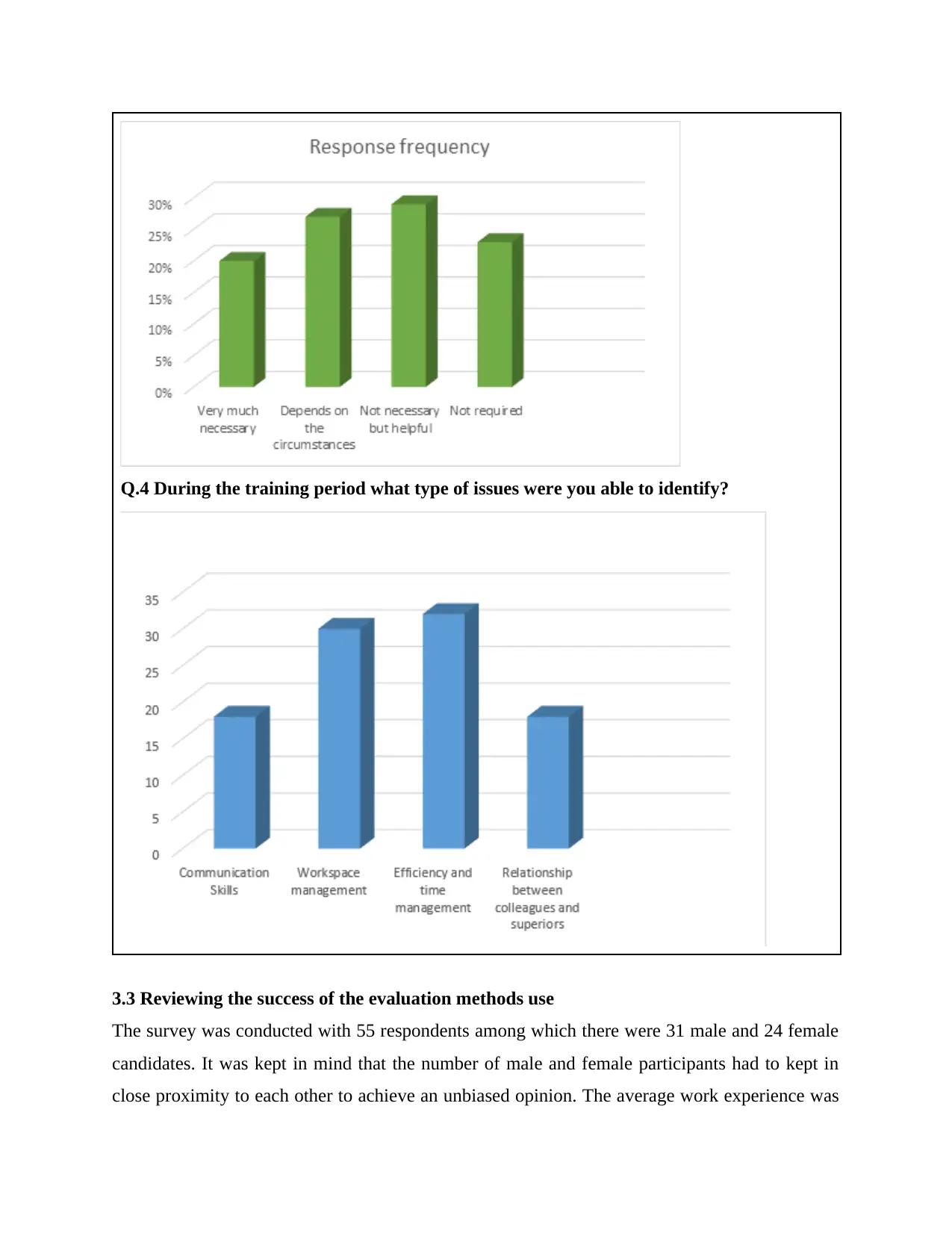
Q.4 During the training period what type of issues were you able to identify?
3.3 Reviewing the success of the evaluation methods use
The survey was conducted with 55 respondents among which there were 31 male and 24 female
candidates. It was kept in mind that the number of male and female participants had to kept in
close proximity to each other to achieve an unbiased opinion. The average work experience was
3.3 Reviewing the success of the evaluation methods use
The survey was conducted with 55 respondents among which there were 31 male and 24 female
candidates. It was kept in mind that the number of male and female participants had to kept in
close proximity to each other to achieve an unbiased opinion. The average work experience was
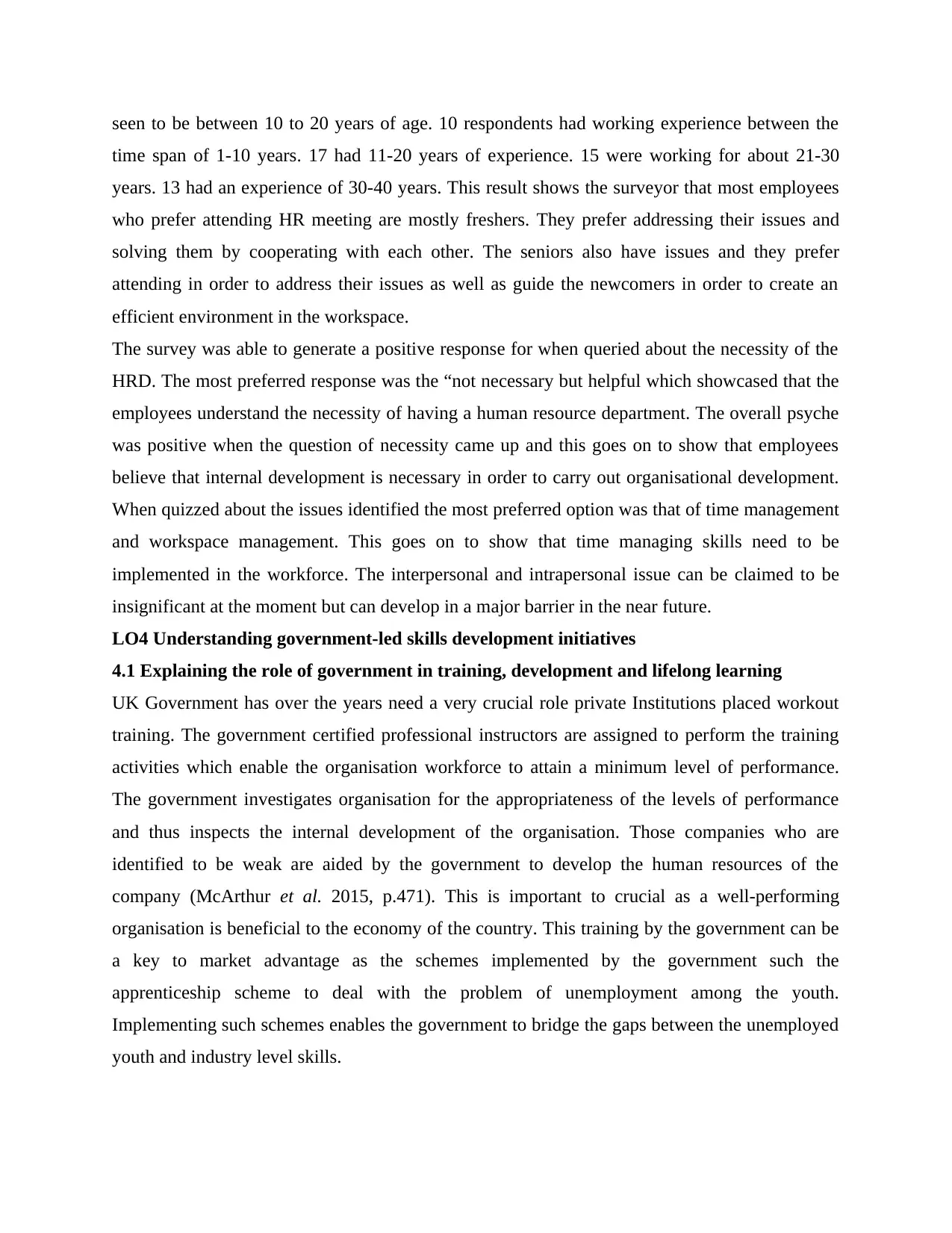
seen to be between 10 to 20 years of age. 10 respondents had working experience between the
time span of 1-10 years. 17 had 11-20 years of experience. 15 were working for about 21-30
years. 13 had an experience of 30-40 years. This result shows the surveyor that most employees
who prefer attending HR meeting are mostly freshers. They prefer addressing their issues and
solving them by cooperating with each other. The seniors also have issues and they prefer
attending in order to address their issues as well as guide the newcomers in order to create an
efficient environment in the workspace.
The survey was able to generate a positive response for when queried about the necessity of the
HRD. The most preferred response was the “not necessary but helpful which showcased that the
employees understand the necessity of having a human resource department. The overall psyche
was positive when the question of necessity came up and this goes on to show that employees
believe that internal development is necessary in order to carry out organisational development.
When quizzed about the issues identified the most preferred option was that of time management
and workspace management. This goes on to show that time managing skills need to be
implemented in the workforce. The interpersonal and intrapersonal issue can be claimed to be
insignificant at the moment but can develop in a major barrier in the near future.
LO4 Understanding government-led skills development initiatives
4.1 Explaining the role of government in training, development and lifelong learning
UK Government has over the years need a very crucial role private Institutions placed workout
training. The government certified professional instructors are assigned to perform the training
activities which enable the organisation workforce to attain a minimum level of performance.
The government investigates organisation for the appropriateness of the levels of performance
and thus inspects the internal development of the organisation. Those companies who are
identified to be weak are aided by the government to develop the human resources of the
company (McArthur et al. 2015, p.471). This is important to crucial as a well-performing
organisation is beneficial to the economy of the country. This training by the government can be
a key to market advantage as the schemes implemented by the government such the
apprenticeship scheme to deal with the problem of unemployment among the youth.
Implementing such schemes enables the government to bridge the gaps between the unemployed
youth and industry level skills.
time span of 1-10 years. 17 had 11-20 years of experience. 15 were working for about 21-30
years. 13 had an experience of 30-40 years. This result shows the surveyor that most employees
who prefer attending HR meeting are mostly freshers. They prefer addressing their issues and
solving them by cooperating with each other. The seniors also have issues and they prefer
attending in order to address their issues as well as guide the newcomers in order to create an
efficient environment in the workspace.
The survey was able to generate a positive response for when queried about the necessity of the
HRD. The most preferred response was the “not necessary but helpful which showcased that the
employees understand the necessity of having a human resource department. The overall psyche
was positive when the question of necessity came up and this goes on to show that employees
believe that internal development is necessary in order to carry out organisational development.
When quizzed about the issues identified the most preferred option was that of time management
and workspace management. This goes on to show that time managing skills need to be
implemented in the workforce. The interpersonal and intrapersonal issue can be claimed to be
insignificant at the moment but can develop in a major barrier in the near future.
LO4 Understanding government-led skills development initiatives
4.1 Explaining the role of government in training, development and lifelong learning
UK Government has over the years need a very crucial role private Institutions placed workout
training. The government certified professional instructors are assigned to perform the training
activities which enable the organisation workforce to attain a minimum level of performance.
The government investigates organisation for the appropriateness of the levels of performance
and thus inspects the internal development of the organisation. Those companies who are
identified to be weak are aided by the government to develop the human resources of the
company (McArthur et al. 2015, p.471). This is important to crucial as a well-performing
organisation is beneficial to the economy of the country. This training by the government can be
a key to market advantage as the schemes implemented by the government such the
apprenticeship scheme to deal with the problem of unemployment among the youth.
Implementing such schemes enables the government to bridge the gaps between the unemployed
youth and industry level skills.
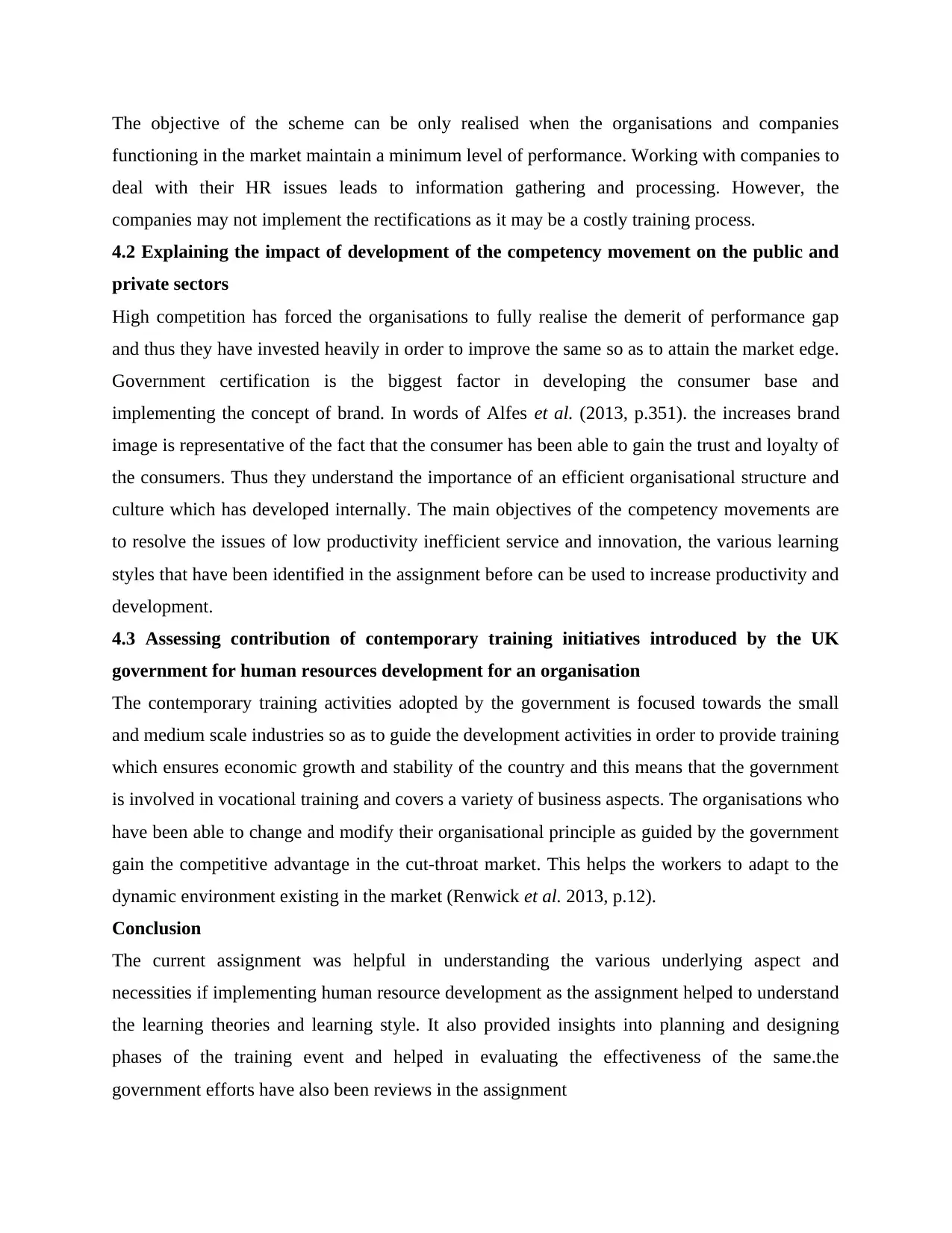
The objective of the scheme can be only realised when the organisations and companies
functioning in the market maintain a minimum level of performance. Working with companies to
deal with their HR issues leads to information gathering and processing. However, the
companies may not implement the rectifications as it may be a costly training process.
4.2 Explaining the impact of development of the competency movement on the public and
private sectors
High competition has forced the organisations to fully realise the demerit of performance gap
and thus they have invested heavily in order to improve the same so as to attain the market edge.
Government certification is the biggest factor in developing the consumer base and
implementing the concept of brand. In words of Alfes et al. (2013, p.351). the increases brand
image is representative of the fact that the consumer has been able to gain the trust and loyalty of
the consumers. Thus they understand the importance of an efficient organisational structure and
culture which has developed internally. The main objectives of the competency movements are
to resolve the issues of low productivity inefficient service and innovation, the various learning
styles that have been identified in the assignment before can be used to increase productivity and
development.
4.3 Assessing contribution of contemporary training initiatives introduced by the UK
government for human resources development for an organisation
The contemporary training activities adopted by the government is focused towards the small
and medium scale industries so as to guide the development activities in order to provide training
which ensures economic growth and stability of the country and this means that the government
is involved in vocational training and covers a variety of business aspects. The organisations who
have been able to change and modify their organisational principle as guided by the government
gain the competitive advantage in the cut-throat market. This helps the workers to adapt to the
dynamic environment existing in the market (Renwick et al. 2013, p.12).
Conclusion
The current assignment was helpful in understanding the various underlying aspect and
necessities if implementing human resource development as the assignment helped to understand
the learning theories and learning style. It also provided insights into planning and designing
phases of the training event and helped in evaluating the effectiveness of the same.the
government efforts have also been reviews in the assignment
functioning in the market maintain a minimum level of performance. Working with companies to
deal with their HR issues leads to information gathering and processing. However, the
companies may not implement the rectifications as it may be a costly training process.
4.2 Explaining the impact of development of the competency movement on the public and
private sectors
High competition has forced the organisations to fully realise the demerit of performance gap
and thus they have invested heavily in order to improve the same so as to attain the market edge.
Government certification is the biggest factor in developing the consumer base and
implementing the concept of brand. In words of Alfes et al. (2013, p.351). the increases brand
image is representative of the fact that the consumer has been able to gain the trust and loyalty of
the consumers. Thus they understand the importance of an efficient organisational structure and
culture which has developed internally. The main objectives of the competency movements are
to resolve the issues of low productivity inefficient service and innovation, the various learning
styles that have been identified in the assignment before can be used to increase productivity and
development.
4.3 Assessing contribution of contemporary training initiatives introduced by the UK
government for human resources development for an organisation
The contemporary training activities adopted by the government is focused towards the small
and medium scale industries so as to guide the development activities in order to provide training
which ensures economic growth and stability of the country and this means that the government
is involved in vocational training and covers a variety of business aspects. The organisations who
have been able to change and modify their organisational principle as guided by the government
gain the competitive advantage in the cut-throat market. This helps the workers to adapt to the
dynamic environment existing in the market (Renwick et al. 2013, p.12).
Conclusion
The current assignment was helpful in understanding the various underlying aspect and
necessities if implementing human resource development as the assignment helped to understand
the learning theories and learning style. It also provided insights into planning and designing
phases of the training event and helped in evaluating the effectiveness of the same.the
government efforts have also been reviews in the assignment
Secure Best Marks with AI Grader
Need help grading? Try our AI Grader for instant feedback on your assignments.
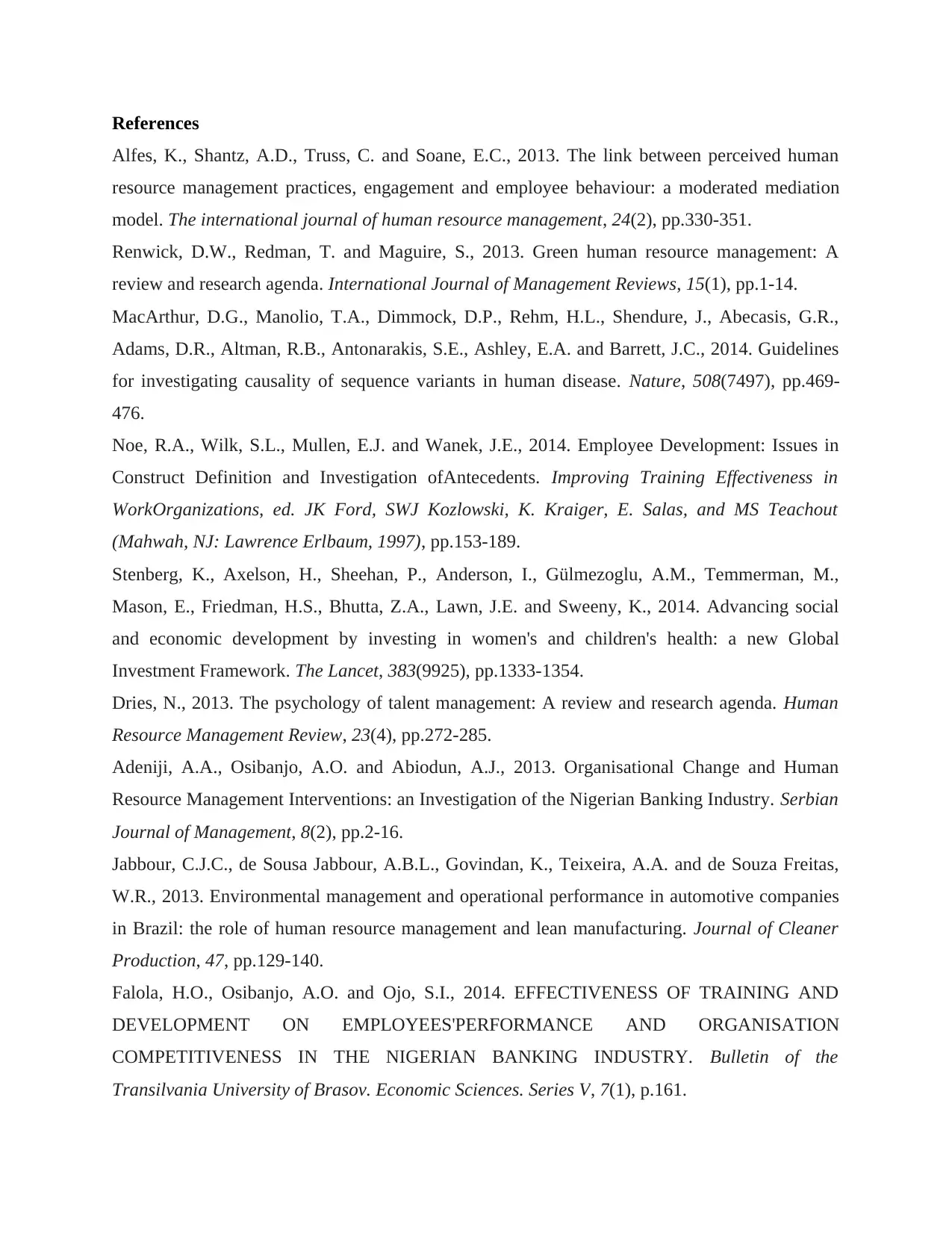
References
Alfes, K., Shantz, A.D., Truss, C. and Soane, E.C., 2013. The link between perceived human
resource management practices, engagement and employee behaviour: a moderated mediation
model. The international journal of human resource management, 24(2), pp.330-351.
Renwick, D.W., Redman, T. and Maguire, S., 2013. Green human resource management: A
review and research agenda. International Journal of Management Reviews, 15(1), pp.1-14.
MacArthur, D.G., Manolio, T.A., Dimmock, D.P., Rehm, H.L., Shendure, J., Abecasis, G.R.,
Adams, D.R., Altman, R.B., Antonarakis, S.E., Ashley, E.A. and Barrett, J.C., 2014. Guidelines
for investigating causality of sequence variants in human disease. Nature, 508(7497), pp.469-
476.
Noe, R.A., Wilk, S.L., Mullen, E.J. and Wanek, J.E., 2014. Employee Development: Issues in
Construct Definition and Investigation ofAntecedents. Improving Training Effectiveness in
WorkOrganizations, ed. JK Ford, SWJ Kozlowski, K. Kraiger, E. Salas, and MS Teachout
(Mahwah, NJ: Lawrence Erlbaum, 1997), pp.153-189.
Stenberg, K., Axelson, H., Sheehan, P., Anderson, I., Gülmezoglu, A.M., Temmerman, M.,
Mason, E., Friedman, H.S., Bhutta, Z.A., Lawn, J.E. and Sweeny, K., 2014. Advancing social
and economic development by investing in women's and children's health: a new Global
Investment Framework. The Lancet, 383(9925), pp.1333-1354.
Dries, N., 2013. The psychology of talent management: A review and research agenda. Human
Resource Management Review, 23(4), pp.272-285.
Adeniji, A.A., Osibanjo, A.O. and Abiodun, A.J., 2013. Organisational Change and Human
Resource Management Interventions: an Investigation of the Nigerian Banking Industry. Serbian
Journal of Management, 8(2), pp.2-16.
Jabbour, C.J.C., de Sousa Jabbour, A.B.L., Govindan, K., Teixeira, A.A. and de Souza Freitas,
W.R., 2013. Environmental management and operational performance in automotive companies
in Brazil: the role of human resource management and lean manufacturing. Journal of Cleaner
Production, 47, pp.129-140.
Falola, H.O., Osibanjo, A.O. and Ojo, S.I., 2014. EFFECTIVENESS OF TRAINING AND
DEVELOPMENT ON EMPLOYEES'PERFORMANCE AND ORGANISATION
COMPETITIVENESS IN THE NIGERIAN BANKING INDUSTRY. Bulletin of the
Transilvania University of Brasov. Economic Sciences. Series V, 7(1), p.161.
Alfes, K., Shantz, A.D., Truss, C. and Soane, E.C., 2013. The link between perceived human
resource management practices, engagement and employee behaviour: a moderated mediation
model. The international journal of human resource management, 24(2), pp.330-351.
Renwick, D.W., Redman, T. and Maguire, S., 2013. Green human resource management: A
review and research agenda. International Journal of Management Reviews, 15(1), pp.1-14.
MacArthur, D.G., Manolio, T.A., Dimmock, D.P., Rehm, H.L., Shendure, J., Abecasis, G.R.,
Adams, D.R., Altman, R.B., Antonarakis, S.E., Ashley, E.A. and Barrett, J.C., 2014. Guidelines
for investigating causality of sequence variants in human disease. Nature, 508(7497), pp.469-
476.
Noe, R.A., Wilk, S.L., Mullen, E.J. and Wanek, J.E., 2014. Employee Development: Issues in
Construct Definition and Investigation ofAntecedents. Improving Training Effectiveness in
WorkOrganizations, ed. JK Ford, SWJ Kozlowski, K. Kraiger, E. Salas, and MS Teachout
(Mahwah, NJ: Lawrence Erlbaum, 1997), pp.153-189.
Stenberg, K., Axelson, H., Sheehan, P., Anderson, I., Gülmezoglu, A.M., Temmerman, M.,
Mason, E., Friedman, H.S., Bhutta, Z.A., Lawn, J.E. and Sweeny, K., 2014. Advancing social
and economic development by investing in women's and children's health: a new Global
Investment Framework. The Lancet, 383(9925), pp.1333-1354.
Dries, N., 2013. The psychology of talent management: A review and research agenda. Human
Resource Management Review, 23(4), pp.272-285.
Adeniji, A.A., Osibanjo, A.O. and Abiodun, A.J., 2013. Organisational Change and Human
Resource Management Interventions: an Investigation of the Nigerian Banking Industry. Serbian
Journal of Management, 8(2), pp.2-16.
Jabbour, C.J.C., de Sousa Jabbour, A.B.L., Govindan, K., Teixeira, A.A. and de Souza Freitas,
W.R., 2013. Environmental management and operational performance in automotive companies
in Brazil: the role of human resource management and lean manufacturing. Journal of Cleaner
Production, 47, pp.129-140.
Falola, H.O., Osibanjo, A.O. and Ojo, S.I., 2014. EFFECTIVENESS OF TRAINING AND
DEVELOPMENT ON EMPLOYEES'PERFORMANCE AND ORGANISATION
COMPETITIVENESS IN THE NIGERIAN BANKING INDUSTRY. Bulletin of the
Transilvania University of Brasov. Economic Sciences. Series V, 7(1), p.161.
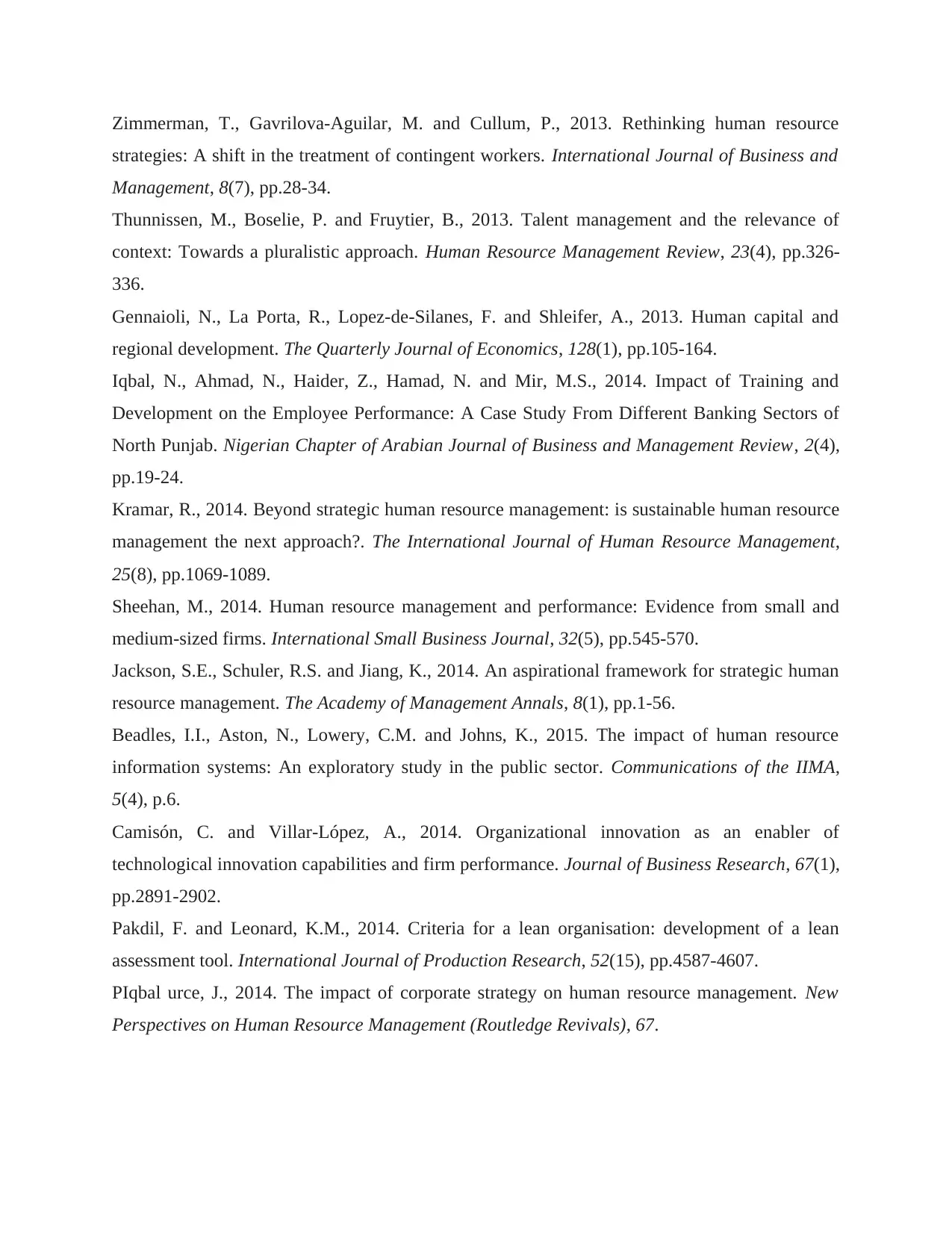
Zimmerman, T., Gavrilova-Aguilar, M. and Cullum, P., 2013. Rethinking human resource
strategies: A shift in the treatment of contingent workers. International Journal of Business and
Management, 8(7), pp.28-34.
Thunnissen, M., Boselie, P. and Fruytier, B., 2013. Talent management and the relevance of
context: Towards a pluralistic approach. Human Resource Management Review, 23(4), pp.326-
336.
Gennaioli, N., La Porta, R., Lopez-de-Silanes, F. and Shleifer, A., 2013. Human capital and
regional development. The Quarterly Journal of Economics, 128(1), pp.105-164.
Iqbal, N., Ahmad, N., Haider, Z., Hamad, N. and Mir, M.S., 2014. Impact of Training and
Development on the Employee Performance: A Case Study From Different Banking Sectors of
North Punjab. Nigerian Chapter of Arabian Journal of Business and Management Review, 2(4),
pp.19-24.
Kramar, R., 2014. Beyond strategic human resource management: is sustainable human resource
management the next approach?. The International Journal of Human Resource Management,
25(8), pp.1069-1089.
Sheehan, M., 2014. Human resource management and performance: Evidence from small and
medium-sized firms. International Small Business Journal, 32(5), pp.545-570.
Jackson, S.E., Schuler, R.S. and Jiang, K., 2014. An aspirational framework for strategic human
resource management. The Academy of Management Annals, 8(1), pp.1-56.
Beadles, I.I., Aston, N., Lowery, C.M. and Johns, K., 2015. The impact of human resource
information systems: An exploratory study in the public sector. Communications of the IIMA,
5(4), p.6.
Camisón, C. and Villar-López, A., 2014. Organizational innovation as an enabler of
technological innovation capabilities and firm performance. Journal of Business Research, 67(1),
pp.2891-2902.
Pakdil, F. and Leonard, K.M., 2014. Criteria for a lean organisation: development of a lean
assessment tool. International Journal of Production Research, 52(15), pp.4587-4607.
PIqbal urce, J., 2014. The impact of corporate strategy on human resource management. New
Perspectives on Human Resource Management (Routledge Revivals), 67.
strategies: A shift in the treatment of contingent workers. International Journal of Business and
Management, 8(7), pp.28-34.
Thunnissen, M., Boselie, P. and Fruytier, B., 2013. Talent management and the relevance of
context: Towards a pluralistic approach. Human Resource Management Review, 23(4), pp.326-
336.
Gennaioli, N., La Porta, R., Lopez-de-Silanes, F. and Shleifer, A., 2013. Human capital and
regional development. The Quarterly Journal of Economics, 128(1), pp.105-164.
Iqbal, N., Ahmad, N., Haider, Z., Hamad, N. and Mir, M.S., 2014. Impact of Training and
Development on the Employee Performance: A Case Study From Different Banking Sectors of
North Punjab. Nigerian Chapter of Arabian Journal of Business and Management Review, 2(4),
pp.19-24.
Kramar, R., 2014. Beyond strategic human resource management: is sustainable human resource
management the next approach?. The International Journal of Human Resource Management,
25(8), pp.1069-1089.
Sheehan, M., 2014. Human resource management and performance: Evidence from small and
medium-sized firms. International Small Business Journal, 32(5), pp.545-570.
Jackson, S.E., Schuler, R.S. and Jiang, K., 2014. An aspirational framework for strategic human
resource management. The Academy of Management Annals, 8(1), pp.1-56.
Beadles, I.I., Aston, N., Lowery, C.M. and Johns, K., 2015. The impact of human resource
information systems: An exploratory study in the public sector. Communications of the IIMA,
5(4), p.6.
Camisón, C. and Villar-López, A., 2014. Organizational innovation as an enabler of
technological innovation capabilities and firm performance. Journal of Business Research, 67(1),
pp.2891-2902.
Pakdil, F. and Leonard, K.M., 2014. Criteria for a lean organisation: development of a lean
assessment tool. International Journal of Production Research, 52(15), pp.4587-4607.
PIqbal urce, J., 2014. The impact of corporate strategy on human resource management. New
Perspectives on Human Resource Management (Routledge Revivals), 67.
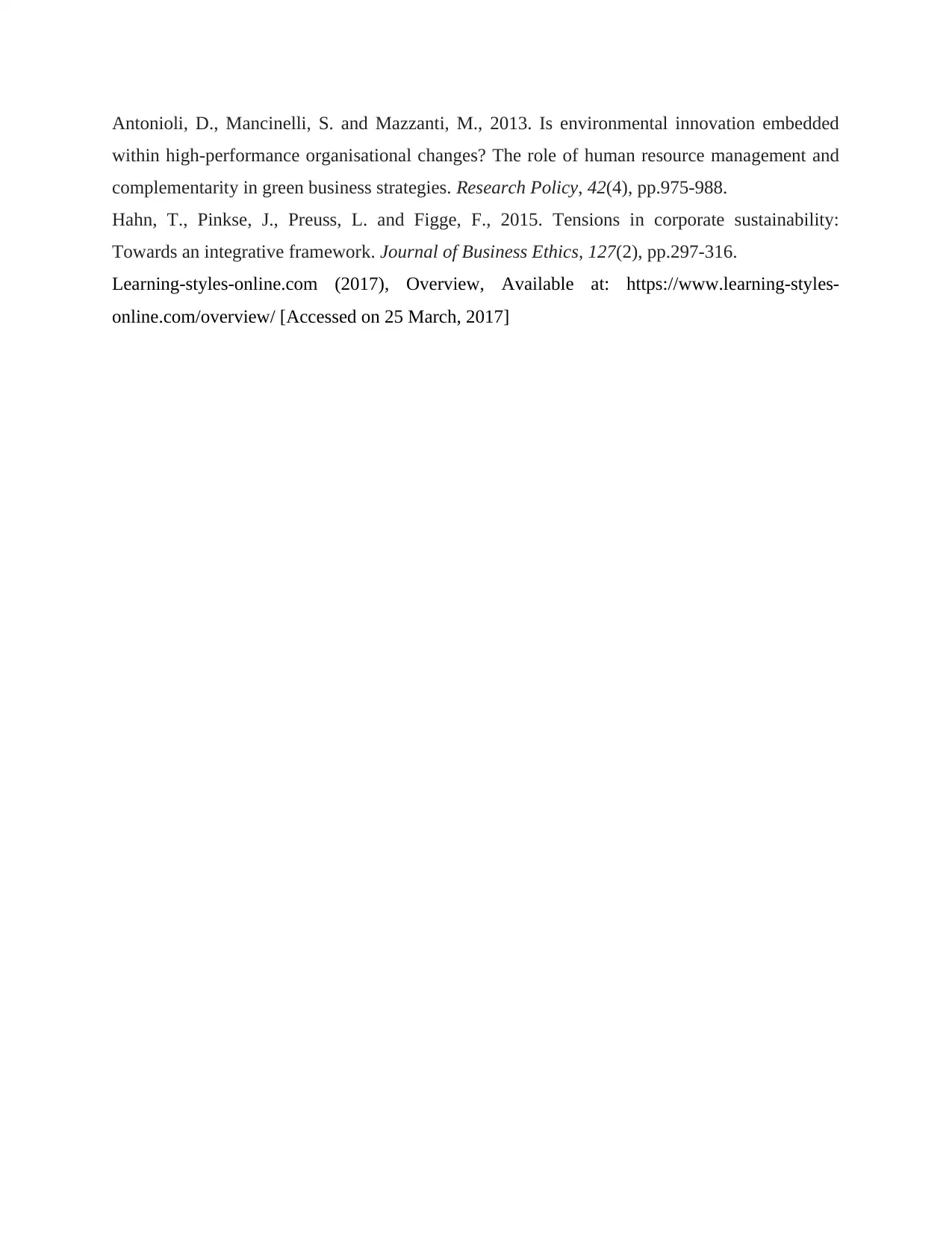
Antonioli, D., Mancinelli, S. and Mazzanti, M., 2013. Is environmental innovation embedded
within high-performance organisational changes? The role of human resource management and
complementarity in green business strategies. Research Policy, 42(4), pp.975-988.
Hahn, T., Pinkse, J., Preuss, L. and Figge, F., 2015. Tensions in corporate sustainability:
Towards an integrative framework. Journal of Business Ethics, 127(2), pp.297-316.
Learning-styles-online.com (2017), Overview, Available at: https://www.learning-styles-
online.com/overview/ [Accessed on 25 March, 2017]
within high-performance organisational changes? The role of human resource management and
complementarity in green business strategies. Research Policy, 42(4), pp.975-988.
Hahn, T., Pinkse, J., Preuss, L. and Figge, F., 2015. Tensions in corporate sustainability:
Towards an integrative framework. Journal of Business Ethics, 127(2), pp.297-316.
Learning-styles-online.com (2017), Overview, Available at: https://www.learning-styles-
online.com/overview/ [Accessed on 25 March, 2017]
1 out of 19
Related Documents
Your All-in-One AI-Powered Toolkit for Academic Success.
+13062052269
info@desklib.com
Available 24*7 on WhatsApp / Email
![[object Object]](/_next/static/media/star-bottom.7253800d.svg)
Unlock your academic potential
© 2024 | Zucol Services PVT LTD | All rights reserved.





